The MAJORS
2024 Preview: The Big 4 Courses, Contenders, Storylines and Sleepers
MAX HOMA
On the cusp of greatness
Plus Heli-skiing in the Alps

TOM WATSON
Inspiring a new generation
• Golfing in a Kilt
WYNDHAM CLARK
Just keeps winning
• Drinking at Royal Troon
• Mastering Match Play
LUXURY | LIFESTYLE | GOLF 60 | SPRING 2024
Pinehurst No. 2 $20 Where Sold

- A n Island Sanctuary like
GORDON
no other cd: ROBB AARON

LOVELANAI.COM












Hotels
Preferred










Stephens STEPHENS INC. • MEMBER NYSE, SIPC • 800-643-9691 LITTLE ROCK, AR | ATLANTA, GA | AUSTIN, TX | BIRMINGHAM, AL | BOSTON, MA | CHARLOTTE, NC | CHICAGO, IL | COLUMBIA, SC | CONWAY, AR | DALLAS, TX | FAYETTEVILLE, AR HOT SPRINGS, AR | HOUSTON, TX | JACKSON, MS | JONESBORO, AR | MEMPHIS, TN | NASHVILLE, TN | NEW YORK, NY | PORTLAND, ME | ROGERS, AR | SAN FRANCISCO, CA SHREVEPORT, LA | ST. PETERSBURG, FL | WASHINGTON, DC | WINSTON-SALEM, NC | FRANKFURT AM MAIN, DE | LONDON, UK
“Golf is a great teacher of the fundamentals of life: patience, diligence, and personal accountability.
Our
Brand Ambassadors exemplify these traits, while standing out as some of the most exciting talent in the game.”
Warren Stephens Chairman, President and CEO
Stephens
Stephens is the Presenting Sponsor of the Jackson T. Stephens Cup and the Simmons Bank Championship.
Watch our Stephens Brand Ambassadors compete in the U.S. and around the world.
PGA Tour: Austin Cook, Nico Echavarria, Andrew Landry, David Lingmerth, Taylor Moore, Mateo Fernandez de Oliveira
LPGA Tour: Maria Fassi, Stacy Lewis, Gaby Lopez, Brooke Matthews, Lilly Thomas
PGA Champions Tour: Dicky Pride

@Stephens_Inc STEPHENS.COM
“Stephens” (the company brand name) is a leading family-owned investment firm that includes Stephens Inc. (member NYSE/SIPC), Stephens Investment Management Group, LLC, Stephens Insurance, LLC, Stephens Capital Partners LLC and Stephens Europe Limited (Registered office: 12 Arthur Street, London, EC4R 9AB, Registered number 8817024), which is authorised and regulated by the Financial Conduct Authority.




The first ever Nicklaus Heritage Course. A 10-hole Tiger Woods Playground Course. Jack’s Bay Club is the first and only residential community in the world with courses by both The Golden Bear and Tiger. 15 holes will be directly on the azure seas and pink sands of Eleuthera, Bahamas.
An oasis for the soul, Jack’s Bay spans 1,200 privately-owned acres and stretches over four miles of beachfront. It features an enviable slate of Club amenities and unforgettable experiences that will leave an imprint on your family.
You are invited to inquire about our Nicklaus Village Residences, Atlantic Club Cottages and a selection of golf/beach homes.
www.jacksbayclub.com/kingdom +1 (800) 320-6281 sales@jacksbayclub.com


YOUR STORY AWAITS
Whatever type of traveler you are, we invite you to embark on a private expedition through paradise that’s anything you want it to be. Whether you choose to fill your days with activities or go where the wind takes you, set sail and discover why there’s nothing like island-hopping aboard your own private yacht.
It’s your vacation, make the most of it with The Moorings.
moorings.com | 800.669.6529


Publisher & Co-Founder
Matthew Squire
Art Director
Matthew Halnan Editors
Robin Barwick (UK)
Shaun Tolson (US)
Head of Advertising Sales
Jon Edwards
GM, Kingdom
Joe Velotta
Contributing Editor
Lori Bryan
Founding Director
Arnold Palmer
Photography
Yann Allègre, Brandon Culver, Matthew
Halnan, Patrick Koenig, Maggie Morris, Evan Schiller, Martin Smith
Special Thanks & Contributors
Wyndham Clark, John Ellis, Max
Homa, Barry Hyde, Curtis McConnell, John F McLeish, Maggie Morris, Alexandra O’Laughlin, Larry Olmsted, Donald Steel, Kieron Stevenson, Paul Trow, Gina DeCaprio Vercesi, Tom Watson, Stewart Wilson
Subscriptions
Order online at: kingdom.golf/the-magazine and receive special subscriber o ers
Or email:
jv@kingdom.golf
Inquiries
Advertising ms@northandwarren.com
Editorial rb@northandwarren.com
Commercial Inquiries
ms@northandwarren.com 646-970-3755 | kingdom.golf
North & Warren
President & Partner
Jay Meyer
Masthead
Executive Vice President, Content
Bruce Wallin
Marketing Director
Emily Poppert
Operations Manager
Mandee Klenk
N&W Partnerships
Christian Poppert, Jana Robinson, Mark Cooper, David Van Sicklen, Tori DeClaris, Travis Haley
Chief Financial Officer
John Pietrolungo
Founders
Matt Carroll, Nick Van Sicklen

Cover 1
Pinehurst No. 2, host course of the 2024 U.S. Open in June.
Photo: Patrick Koenig pjkoenig.com
Cover 2
e Club at Seven Canyons in Sedona, Arizona.
Kingdom magazine was first available to friends and associates of Arnold Palmer, and members and guests of his designed and managed courses. Now it is available at distinguished private clubs and for discerning golfers everywhere. Printed in
© 2024 North & Warren, LLC. Reproduction without permission is prohibited. The articles appearing within this publication reflect the opinion of their respective authors and not necessarily those of the publisher. The contents of advertisements and advertorials are entirely the responsibility of advertisers. No responsibility is taken for unsolicited submissions and manuscripts. Published by 7324 Gaston Ave, Ste 124-451; Dallas, TX 75214 Socials Visit 60 | SPRING 2024 Newsletter
at:
014 —KINGDOM—ISSUE 60
the USA
Subscribe
kingdom.golf/the-turn












Those Blooming Azaleas

For many, the golf season really does not start until more than 30 varieties of azaleas burst into bloom at Augusta National, right on cue for the Masters. As a Brit, this is certainly true for me, as it is not until April that the rain clouds start to roll away, the days lengthen, temperatures rise (a little!) and sunshine begins to brighten our hallowed links.
amazing depth of strength. There are so many exciting players coming through the ranks, and I was delighted to see PGA Tour rookie Jake Knapp chalk up his first win at the Mexico Open.
Pub Letter
One of my favorite links courses is Royal Troon, which will host this year’s Open. It will be the 10th time Troon has been an Open venue, and 100 years since the Claret Jug first visited this famed links. Arnold Palmer successfully defended his title of Open Champion at Troon in 1962—after his victory at Royal Birkdale in 1961—and it is widely recognized that Palmer’s impact revived The Open’s fortunes. Read more about the ’62 Open in this issue.
I was impressed with how Scottie Scheffler turned his putting around to win his second Arnold Palmer Invitational in such spectacular style at Arnold Palmer’s Bay Hill Club & Lodge—and then he did it all again a few days later at the Players Championship. As the first player to win the Players back-to-back, Scheffler could well be on track to go one step further and win back-to-back majors! He would be the first to do so since Brooks Koepka in 2018.
Scheffler is the man of the moment as I write, although the professional tours continue to enjoy
We are also in full swing here at Kingdom. Look for an exciting editorial redesign later this year, followed by the introduction of the Kingdom VIP Club.
I also urge you to check out the latest on our flagship event, the Kingdom Cup, by visiting kingdom.golf. Our special annual gathering will this year be hosted at The Sea Pines Resort on idyllic Hilton Head Island. One of our VIP guests this year will be the legendary Tom Watson, and we were fortunate to interview this five-time British Open champ for this issue. Fittingly, Watson has become the first ever global ambassador for The Open.
Finally, this is the first issue of Kingdom we have published since my dearest Dad passed, and I would like to dedicate this issue to him. My dad got me into golf, and for that I will be eternally grateful. I like to think that he has enjoyed a few rounds with Arnie, up above. Remember to cherish the time you share with your loved ones, every second that you can.
Be well,

016 —KINGDOM—ISSUE 60
PUBLISHER’S LETTER






















Golf, Scotch and kilts come together at a novel new tournament in the Scottish Highlands.
At this Alpine retreat, you don’t need to be an extreme athlete to enjoy the ultimate skiing experience.
Seven multigenerational adventures sure to thrill family members of all ages.
TOC 018 —KINGDOM—ISSUE 60 Issue 60 Spring 2024 The Approach 22 Major Venue: Valhalla 24 The New Nemacolin 26 Palmer’s Craft Farms 28 Gleneagles at 100 33 Cigar-Bourbon Blends 36 High-Speed Convertibles 44 Golf Cart Gadgets 46 Warikomi Knives 48 Louisville Weekend 52 Designer Phil Smith 57 Majors in Waiting 58 Tom Watson 63 Golf Course Homes 68 The King of Cool The Majors 73 Majors and Minors Paul Trow previews the courses, contenders, sleepers and storylines at pro golf’s main events. 84 The Scenic Route It’s hard not to root for Max Homa, who is nally living up to his vast potential. 90 Wyndham’s Winning Ways e defending U.S. Open champ heads into majors season on a roll. 98 Riot at Royal Troon Arnold Palmer was known to attract a crowd—but not like the one at the 1962 Open.
The New Matchmakers
Travel 104
Golf resorts are rewriting the rules with courses designed speci cally for match play.
112 A Man and a Half
116 Heli for All
124 The Everyone Escape
63 90 116







Lifestyle
132 Major Mixology Kingdom headed to the Marine Troon hotel to conjure up a quartet of cocktails for 2024’s Big 4 golf events.
138 Independent Spirit ough common in the UK, independent bottlers have been basically nonexistent in the States—until now.
142 Showstoppers e most captivating new golf fashions from the 2024 PGA Show in Orlando.
146 Love of the Game
Marshall Rabil honors his grandmother’s legacy in the boardroom and on the golf course.
148 Kingdom Clubhouse
Publisher’s picks and other sta favorites for spring.
TOC
156 Course Profiles
Pinehurst’s rst new design in almost 30 years, Palmer’s vertical classic in the Great Smokies, and a game-changing addition to Orlando’s golf scene.
162 Coming Next Issue
Previewing Kingdom’s special summer Travel Issue.




























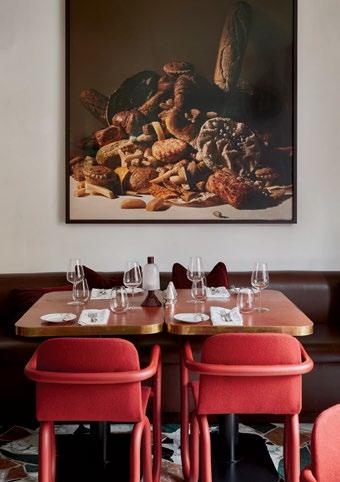

156 132 CONTENTS 148 020 —KINGDOM—ISSUE 60
September 12 - 15, 2024

Join Kingdom & Hilton Head Island for a weekend of world-class golf & luxury island lifestyle.
PLUS: Special guests from the world of golf || Live entertainment VIP events || Two-day tournament at Harbour Town Golf Links & Heron Point by Pete Dye at The Sea Pines Resort
Purchase Tickets: Kingdom.golf/cup

LIKE NO OTHER
A GOLF TOURNAMENT
Heron Point by Pete Dye, Photo Courtesy of The Sea Pines Resort
THE APPROACH
Major Venue


Valhalla Golf Club, Kentucky
A renovated and elongated Jack Nicklaus design in Louisville, Kentucky, will stage the PGA Championship in May. Previously owned by the PGA of America, Valhalla Golf Club was acquired by a consortium of four local businessmen in 2022. Among the course changes are a newly built island green and a water feature on the famous 13th hole (pictured), where the use of Kentucky limestone is prominent.
“Limestone is very important in Kentucky,” explains Jimmy Kirchdorfer, Valhalla co-owner and general chairman of the 2024 PGA Championship. “It is one of the reasons we have the bourbon and horse industries in Kentucky. Our limestone geology filters the water, which makes great bourbon, and the water is rich in calcium and low in impurities, which is great for the horses.
“When people drive through the gates, they are going to see a lot of naturally exposed limestone, white picket fences and dry-stacked serpentine and limestone walls, like those built in Lexington hundreds of years ago,” Kirchdorfer continues. “When people come to Valhalla, we want them to know they are in Kentucky.”

022 —KINGDOM—ISSUE 60
30 Media
Photo:
Drone

ISSUE 60—KINGDOM 023

024 —KINGDOM—ISSUE 60
THE APPROACH Resort Renaissance
Nemacolin Resort, Pennsylvania
It’s been almost 30 years since Pete Dye carved the dramatic and demanding Mystic Rock golf course through the Laurel Highlands of western Pennsylvania. More recently, designer Tim Liddy updated and softened the 7,550-yard layout at Nemacolin Resort, removing 40,000 square feet of bunker coverage and eliminating several waste areas. In doing so, Liddy made the previous PGA Tour venue more playable for the average amateur, while creating interesting new angles into greens. Nemacolin’s evolution extends to the resort at large, where the Grand Lodge recently reopened following an extensive renovation. The hotel now features 56 suites, butler service and a farm-to-table steakhouse that highlights locally sourced ingredients. Later this summer, the Chateau, a neighboring hotel at the resort, will reemerge following a makeover of similar magnitude.


ISSUE 60—KINGDOM 025
Photo: Evan Schiller

THE APPROACH Palmer Classic

Craft Farms, Alabama
“You must play boldly to win.” Arnold Palmer made this declaration often during his career as a professional golfer—and routinely backed it up with his shot selections on the course. The King also followed that mantra as the designer of Cotton Creek, the first of two golf courses that he would create at Craft Farms Golf Resort. Palmer shaped the former corn and soybean fields, set just north of the white sandy beaches of Gulf Shores, Alabama, into a dynamic canvas of mounds and moguls. Opened in 1987, the challenging, 7,127-yard layout often demands—and rewards—bold shots.
Six years later, Palmer juxtaposed that gauntlet with Craft Farms’ Cypress Bend, a less challenging course defined by inviting fairways and receptive greens.

026 —KINGDOM—ISSUE 60

ISSUE 60—KINGDOM 027

028 —KINGDOM—ISSUE 60
THE APPROACH Centennial Celebration
Gleneagles Hotel, Scotland
“If heaven is anything like this,” Lee Trevino once said of Gleneagles, “I hope they save me a tee time.”
Since opening in the rolling Ochil Hills of Perthshire, in central Scotland, on June 6, 1924, the Gleneagles Hotel has seduced several other notables from the golf world and beyond. Among them was Bob Hope, who, when asked why he loved Scotland so much, said, “Because the people are so warm, and they have got Gleneagles.”
As it celebrates its centennial this summer, Gleneagles remains the ultimate Scottish country estate. Many know it for its three golf courses, but the resort also stands out for its myriad outdoor pursuits—from falconry to four-wheeling—natural setting and grand hotel, with its Michelin two-star restaurant and art deco American Bar.
On the golf front, Gleneagles is the only European venue to have hosted both the Ryder Cup and the Solheim Cup. Before the hotel was even built, the estate hosted the first golf matches played between Great Britain and the United States, in 1921—in a precursor to the Ryder Cup. Golfers in the tournament had to stay in old railway carriages and fetch their own water—a scene that could not be further from the luxury on offer at the century-old hotel today.


ISSUE 60—KINGDOM 029
Photo: Martin Smith



Roll

Reversal
No 19 - Ferio Tego Cigars
A nascent cigar company with a winemaker’s approach, and a unique bourbon distilled with cigars in mind.
Cigar enthusiasts may already know Ferio Tego as the burgeoning company that saved the Timeless and Metropolitan brands from extinction. The more flavorful Ferio Tego story, as it were, isn’t about the revitalization efforts of those ex–Nat Sherman labels. Instead, it follows the company’s flagship blends, Elegancia and Generoso, as well as its latest core release, Summa.
Think of Summa as you would a non-age-statement whiskey blend. Just
as master distillers and blenders ensure that each batch of whiskey tastes the same as previous batches, Ferio Tego aims to make sure that each Summa cigar delivers a consistent smoking experience. In the case of this fullbodied cigar, that experience means a velvety mouthfeel; a rich, robust flavor up front; and a hint of fruity spice on the finish.
Elegancia and Generoso, by contrast, exhibit subtle nuances from one year to the next. “It’s no different
than a winemaker trying to make the best Chardonnay or Cabernet that he or she can that particular year,” Michael Herklots, Ferio Tego’s principal and co-founder, explains. “They do that not by tasting last year’s wine. They do it by knowing what it should be in their heart and on their palate and in their memory, and creating the best version of it that year and every year.”
Elegancia is akin to an elegant Chardonnay with a creamy, fullbodied smoke that tastes of toasted
ISSUE 60—KINGDOM— 033 THE APPROACH No. 19

Blend; Summa cigars from Ferio Tego.

“Summa is an action movie. It tells you what’s going to happen in the first puff.”
No 19 - Ferio Tego Cigars
Smoking Spirit
—Michael Herklots
brioche, cappuccino and vanilla custard. Generoso’s smoke is deeper, more Cabernet Sauvignon like, with plenty of baking spice, black coffee and a bitter cocoa nib character.
Of course, if a whiskey is what you’re looking for, Herklots has the answer. “Summa is an action movie,” he says. “It tells you what’s going to happen in the first puff and, to me, that’s bourbon. It’s not going to change dramatically in the glass.”
As a cigar can evoke a bourbon, so too can a bourbon speak to cigar lovers. Such is the case with Joseph A. Magnus Cigar Blend, an overproof bourbon that, ironically, master blender Nancy Fraley first thought of when she was smoking a pipe (Comoy’s of London Cask #2 Portwood tobacco, to be specific). When she began crafting the whiskey’s original blend, however, she paired it with Davidoff’s Signature 2000 and Anniversario Special R cigars, since they both emphasized the liquor’s nutty, spicy qualities.
Fraley’s Cigar Blend begins with an assemblage of at least eight (but as many as 16) barrels, each selected for its unique character and cherry-picked from hundreds of examples. Crafted from different mashbills and varying in age—the youngest typically 10 years old, the oldest exceeding 18 years—these
individual bourbons may be chosen for showcasing spicier rye notes or perhaps hints of tobacco. Of course, the flavors that epitomize good bourbon, namely sweet fruit paired with soft vanilla and caramel notes, must also be present.
Once the flavors of those distinct barrels have melded, the blend is finished in former Armagnac casks for at least a couple of months, though typically no more than five. Each cask is then bottled as its own batch. The end result is a complex whiskey teeming with aromas of leather and spice.
Sipping the Joseph A. Magnus Cigar Blend brings forth a swirl of flavors that transitions from stewed fruits to caramel corn and candied apples. The only thing missing is a cigar, but that’s an easy fix. After all, Herklots created Summa for just such an occasion. —shaun tolson
034 —KINGDOM—ISSUE 60
Joseph A. Magnus Cigar
















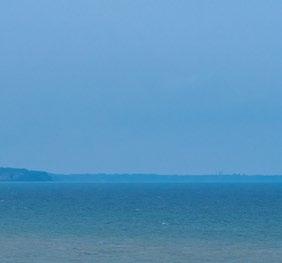











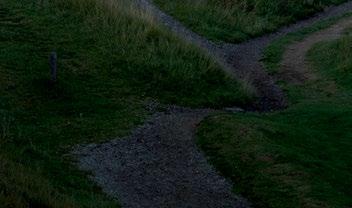









KOHLER, WISCONSIN | DESTINATIONKOHLER.COM | 888-297-7846 WHISTLING STRAITS | STRAITS COURSE, HOLE 7 | PHOTO CREDIT: EVAN SCHILLER
OF
AND THE RYDER CUP
HOST
SIX MAJORS

OPEN SEASON
036 —KINGDOM—ISSUE 60
Spring calls for a convertible. Here, four new models that take topdown driving to new heights.
By Shaun Tolson
Maserati MC20 Cielo
The spyder variant of Maserati’s latest supercar takes its name from the Italian word for sky—and it can connect you with its namesake even when the roof is closed. Crafted from electrochromic material (aka, smart glass), the MC20 Cielo’s roof features polymerdispersed liquid crystal technology that allows it to transition from opaque to clear at the touch of a button. For the full effect, however, retract the top, opening yourself not only to the elements but also to the voracious growl of the Cielo’s 3.0-liter, twin-turbo V6 Nettuno engine. The 630 hp beast, much like the car’s carbon-fiber monocoque and underbody, derives from Maserati’s Formula 1 ventures and can push this highly pedigreed beauty from zero to 199 mph in just over 9 seconds.
Bentley Continental GTC Azure
Maserati MC20
Cielo (opposite) and the Bentley Continental GTC Azure’s luxuriously appointed interior (right).
Machines - Convertibles
No one buys a Bentley for the performance alone, but the luxury British automaker’s vehicles are as impressive for their power and agility as they are for their smooth ride and supple interiors. Such is certainly the case with the new Continental GTC Azure, a convertible that was designed in tandem with neuroscientists and reflects research on the impact of color, texture, tactility and scent on the driver and passenger experience. The end result is a highperformance, drop-top cruiser equipped with a 4.0-liter V8 engine and interior accents such as Wilton wool carpets and lofted-diamond-quilting upholstery. Of course, there may be no greater mood enhancer than retracting the Azure’s roof—and subsequently opening the throttle—on a blue-sky day.

ISSUE 60—KINGDOM— 037
THE APPROACH Wheels



HR for fast-growing companies with a vision
Struggling to keep your business compliant and competitive in changing times? Navigate business challenges with the assurance that comes from Insperity’s unmatched HR service and support.
Whether you need help keeping up with evolving labor laws, attracting and retaining diverse talent in a tight market, leading remote teams or overcoming some other HR obstacle, you can move forward with Insperity behind you.
FULL-SERVICE
HR EMPLOYEE BENEFITS HR TECHNOLOGY







Learn more at insperity.com or call 800.465.3800.
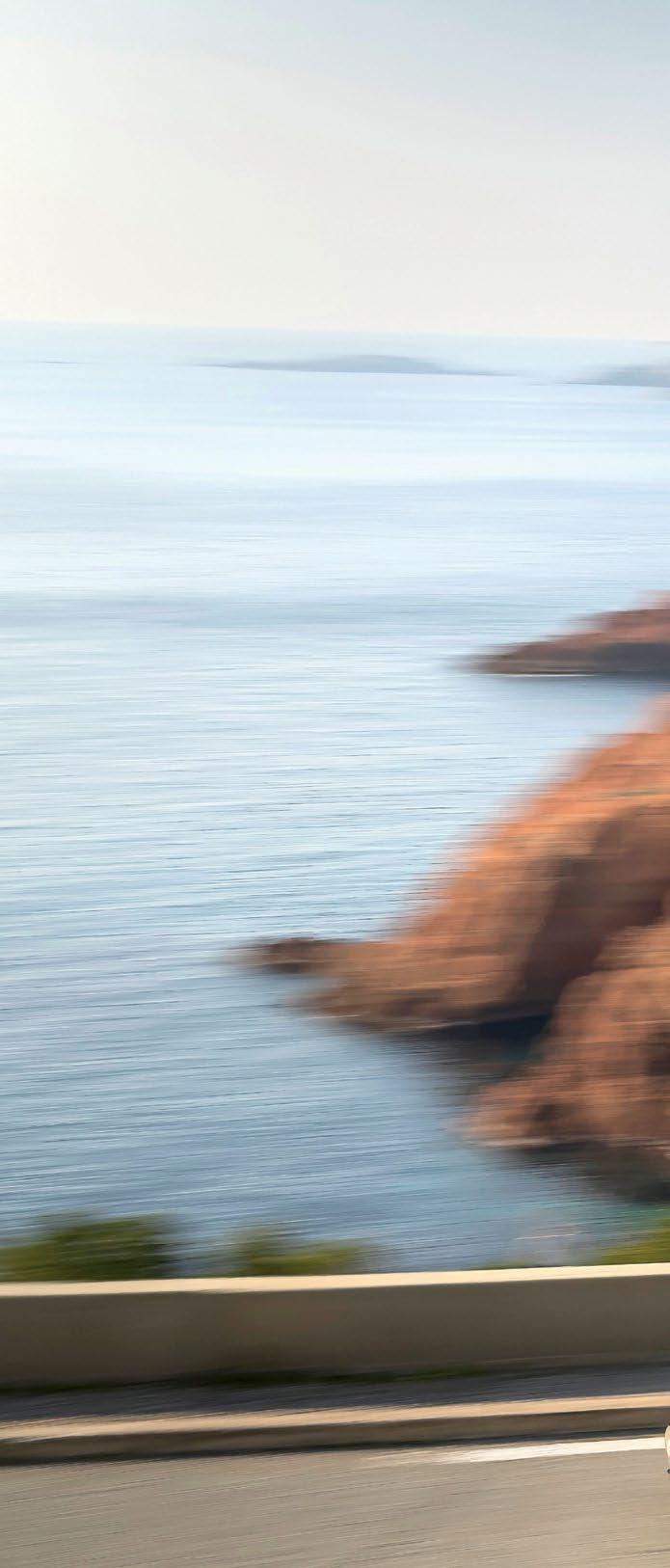

Even with its fairly tame, 2.0-liter, 181 hp engine, the latest Miata (available with a soft top or retractable hardtop) delivers a rush of adrenaline for drivers—thanks in part to a curb weight that peaks at less than 2,500 pounds. Purists will delight in the Sport and Club models (starting at around $30,000), with their six-speed manual transmissions, but the two-seater is also available as a quickshifting, six-speed automatic featuring steering wheel–mounted paddle shifters. All new Miatas benefit from Mazda’s software-based suspension-performance technology, Kinematic Posture Control, which applies braking to the inner rear wheel when the vehicle’s sensors detect high g-forces while cornering.
ISSUE 60—KINGDOM— 039
Mazda Miata MX-5

Chevrolet Corvette Z06

Chevrolet describes the sound that emanates from the 2024 Z06 as a “distinctive exhaust note.” We prefer to think of it as an unmistakable battle cry, one that declares this contemporary Corvette the king of modern American muscle. With a 5.5-liter, dual-overhead-camshaft V8 engine capable of reaching an 8,600-rpm redline, the latest Z06 is available with a Carbon Aero package that maximizes downforce and maneuverability and instantly transforms it into a track star. But in true ’Vette style, the car is equally suited for everyday driving, boosted by an infotainment system with a built-in Google operating program that delivers real-time navigation and traffic reports. Those updates should come in handy for Z06 drivers, who will always be on the lookout for open roads on which to exploit the convertible’s zero-to60-mph time of just 2.6 seconds.
040 —KINGDOM—ISSUE 60

GOLF CLUBS FLY FOR FREE Turkish
is
turkishairlines.com
Airlines
offering you the highest quality service both on the ground and in the air.
Terms and conditions apply. Please visit our website for more details. For international flights, the first golfing set is free of charge, and the special baggage fee is applied for the second and subsequent sets.
TEE UP AND TAKE YOUR GAME TO NEW DESTINATIONS WITH TURKISH AIRLINES
As a longtime sponsor of the Turkish Airlines World Golf Cup and many other golfing events, Turkish Airlines supports the deep-rooted passion behind the sport. Making it more convenient for golf-lovers to take their passion to new destinations, the airline offers passengers the opportunity to carry their first set of golf clubs and golf equipment, such as golf shoes and a golf bag, free of charge on all Turkish Airlines flights.
Flying to more countries than any other airline in the world, Turkish Airlines invites passengers to visit their favorite destinations and discover new horizons with comfort and ease. From its 12 United States gateways, the airline seamlessly connects passengers through its centrally located hub in Istanbul to more than 340 destinations in 129 countries across five continents.






















New Turkish Airlines Lounge at JFK



Award-Winning Business Class Service

As of 2023, Turkish Airlines now offers passengers transiting through Terminal 1 of New York’s John F. Kennedy International Airport (JFK) an elevated lounge true to the Turkish Airlines experience. The lounge amenities are synonymous with the brand’s comfort and hospitality in the newly renovated and rebranded space. Featuring the famous flavors of Turkish cuisine, passengers can enjoy three meals a day including breakfast, lunch and dinner served uninterruptedly, in a thoughtfully designed mid-century inspired space created for function and comfort.

In addition to having one of the most robust flight networks, Turkish Airlines offers an award-winning Business Class service. Business class passengers enjoy modern full flat seats with a first-rate entertainment system, free WIFI service on all wide body fleet, active noise-canceling headphones by Denon, a Ferragamo special amenity kit, a welcome drink and dedicated bar, turnup service and sleeping kit on long haul flights, a snack bar, Turkish coffee and Turkish delight service, a special menu with gourmet meals, hot towel service, dedicated lavatory with live plants, and more.




A Premium Onboard Dining Experience
Turkish Airlines
Stopover Service – Discover the Wonders of Istanbul and Beyond


Turkish Airlines offers passengers award-winning cuisine featuring premium menus prepared with fresh ingredients, courtesy of Turkish DO & CO. With a strong commitment for its quality of service and maintaining its status of the airline with the world’s best inflight dining concept, Turkish Airlines launched new inflight menus this year for domestic and international flights. The new menus draw inspiration from healthy nutrition trends and include eclectic flavors from traditional Turkish cuisine and global cuisines, with 80% of ingredients sourced from local producers. Flying Chefs, a unique in-flight chef service offered on all long-distance flights and some short distance flights, offers passengers the luxury experience of dining at a restaurant high above the clouds.
Turkish Airlines offers its passengers the opportunity to discover the world’s connection center, Istanbul, and its unique wonders with its stopover accommodation service for passengers with lengthy transfer times. As part of its Stopover Service, Turkish Airlines provides a two-night stay in a 4-star hotel for economy class travelers and a three-night stay in a 5-star hotel for business class passengers.
For travelers looking to extend their stay, Türkiye offers 24 golf courses, 15 of which are nestled together in Antalya in the region of Belek, close to the Mediterranean Sea, and known as the Turkish Riviera. Antalya, notably the Belek resort area, offers luxury hotels and resorts with international standards of luxury, superb accommodations, a gourmet dining and pampering service and features numerous championship courses.


Türkiye is a modern country with a captivating blend of antiquity and contemporary and of East and West. The cradle of civilization and center of world history today stands as one of the fastest-growing tourism destinations in the world. Its spectacular coastline, majestic mountains, cosmopolitan cities, and quaint villages make it one of the world’s most fascinating destinations.




COMPLIMENTARY HOTEL STAY AND EASY VISA
2 nights for Economy Class
3 nights for Business Class



You can extend your stay with special prices starting from 49 USD per night


Cart Companions
Bring the comforts of home to the golf course with these portable picks.
1. Penfold Heritage accessories pouch, penfoldgolf.net, $40.
2. PRG Arnold Palmer Umbrella Duo ball marker, prg-golf.com, $35.
3. Revo Sierra sunglasses, revo.com, $299.

044 —KINGDOM—ISSUE 60
APPROACH Gear
THE
1 2 2 3



Fashion 1- Gadgets

ISSUE 60—KINGDOM— 045
4. Wacaco Picopresso portable espresso machine, wacaco.com, $129.
5. Blue Tees Golf Player+ GPS speaker, blueteesgolf.com, $249.
6. S.T. Dupont Defi XXtreme lighter, st-dupont.com, $345.
4 5 6 7
7. Xikar Xi3 cigar cutter, xikar.com, $159.
Precision CUT
Blacksmith Haruki Miyazaki applies ancient Japanese techniques to create highly specialized and greatly prized kitchen blades.
Handcrafted - Knives
Far off the western coast of Japan in the remote Goto Islands, sparks fly around Haruki Miyazaki as he splits a glowing piece of 1,800°F iron, inserts a sliver of steel, and pounds the metals together. So begins the multistep process behind the 38-year-old blacksmith’s highly sought-after kitchen blades, from all-purpose Hakata knives to Yanagiba sashimi knives.
Miyazaki practices the loud and intensely physical warikomi blacksmithing method passed down from Japanese swordsmiths during the Sakoku period between 1639 and 1853. In Japan, this period—when the nation was kept isolated from the rest of the world—is understood to be one of vibrant, original, cultural creativity, a time when artisans in the country evolved their craft, influenced only through teachings of their predecessors. In culinary history, this is when haute kaiseki cuisine emerged, a style of food preparation and service that required highly specialized kitchen tools.
Through a translator, Miyazaki emphasizes the importance of having tools specific to the type of food being prepared. For example, precise preparation of unagi (eel) requires six different knives. “When you prepare fish,” he says, “you don’t want to chop and


046 —KINGDOM—ISSUE 60 THE APPROACH Handcrafted
Photos: Maggie Morris
Due to the time and skill required for each of his knives, Miyazaki makes only about 500 each year.

“It must be done in one slice to preserve the flavor and presentation, to respect the life that was given.”
—Haruki Miyazaki

Handcrafted - Knives
saw that blacksmithing shops were disappearing across Japan. Miyazaki apprenticed for five years under a master from the Oba blacksmith family in Fukuoka, who specialized in the Hakata Bocho–shaped kitchen knife. After completing his apprenticeship, he set up his workshop and traveled around the country, continuing to learn from different blacksmiths.
hack at it. It must be done in one slice to preserve the flavor and presentation, to respect the life that was given. You’re taking a little bit of the soul. You must show respect.”
Growing up, Miyazaki relocated with his family from the sanctuary-like atmosphere of Goto to various countries abroad, following his father’s work as a physician. While this expanded his worldview, it also gave him a bit of culture shock as he saw societies hooked on mass production. After high school, he and his younger brother returned to Goto, committed to eschewing modern, industrial production. His father had taught him about blacksmithing culture, and he
Today, Miyazaki lives next to his workshop with his wife, Natsumi, who produces handmade leather sheaths for all his pieces, and their two small children. (His brother, Koichi, lives down the road and carves cedar basins by hand, using a method practiced by only 10 craftsmen in the world.) In the corner of his studio is a cement-and-brick forge heated by pine charcoal. Once he has heated the iron and inserted the slice of steel, he cuts out the merged materials, forms and unifies them before cooling, then laminates and sharpens, a process finished over several days. Finally, he fits his blades with handles handcarved from the island’s camellia trees, each bearing Miyazaki’s signature camellia flower stamp. The result: a glimmering culinary weapon with a wavelike pattern rippling across the blade.
maggie morris
ISSUE 60—KINGDOM— 047
All in on LOUISVILLE
With the PGA Championship coming to Valhalla Golf Club—and the 150th running of the Kentucky Derby in May—it’s a great time for a quick trip to the Gateway to the South.
Golf Getaway

Weekender - Louisville

Stay: Louisville doesn’t have a golf resort per se, but the original 21c Museum Hotel is convenient to several courses—and far cooler than your average golf resort. (You can recognize it by the double-life-sized replica of Michelangelo’s David outside.) Combined from five 19th-century warehouses, the art-centric hotel includes nearly 10,000 square feet of exhibition space, along with Proof on Main, one of the city’s best restaurants.
Play: If you can get onto Valhalla or the private Lake Forest Country Club—Kentucky’s only Arnold Palmer
design—do so. Also be sure to tee it up at Quail Chase, perennially ranked as the city’s best public facility. With 27 holes, the club can be played as two 18s, West and South. Two other favorites of local golfers are the sibling Fuzzy Zoeller designs, Covered Bridge and Champions Pointe, just 15 minutes across the Indiana border in “Kentuckiana.” For a trip back in time, head to Shawnee, on the banks of the Ohio River in Downtown Louisville, which hosted the 1932 U.S. Amateur Public Links, or to the nine-hole Cherokee, which dates to 1895 and is one of the oldest munis in the nation.
Eat: For the classic flavor of Louisville, grab a table at the historic Brown Hotel, where the city’s signature dish, the “Hot Brown,” was created as a hangover remedy in 1926. An open-face sandwich broiled to brown in a sauté pan, it layers handcarved turkey, Mornay sauce, cheese, bacon and tomatoes. For a more contemporary spin on Southern fare, 610 Magnolia from three-time James Beard nominee Edward Lee is the city’s most acclaimed eatery. Enjoy dishes such as local duck breast with Carolina dirty rice, charred okra and hoisin sauce, or butternut-squash-andgoat-cheese agnolotti with black garlic and crispy sage.

048 —KINGDOM—ISSUE 60 THE APPROACH Weekend Two Ways


Whiskey Weekend
Weekender - Louisville

Stay: Hotel Distil is a recent addition to Downtown’s revived Whiskey Row, once the epicenter of the bourbon industry and now the city’s touristic heart. Behind its original bourbon-barreling warehouse façade, the Marriott Autograph Collection hotel is modern and swank. Sample its huge whiskey list at the open-air second-floor bar and the standout Repeal Oak Fired Steakhouse, where meat is cooked over a live fire of bourbon barrel staves—as delicious as it is gimmicky.
Sip: Several Downtown distilleries or visitor’s centers are steps away from Hotel Distil, including Rabbit Hole, Angel’s Envy, Kentucky Peerless, Michter’s and Old Forester. Two of the city’s best whiskey bars are within a two-minute stroll, the intimate Frank’s Whiskey Place and the huge Down One Bourbon Bar, featuring more
than 120 whiskies including harderto-find pours like Pappy Van Winkle, King of Kentucky, Weller CYPB and George T. Stagg. Just outside the city, you’ll find the larger, campus-style distilleries of Stitzel-Weller—producer of Blade and Bow, I.W. Harper and the Orphan Barrel series—and Kentucky Artisan Distillery, which makes Jefferson’s. About 45 minutes from the city center, Bulleit Frontier Whiskey offers a modern tasting tour at its high-tech distillery.
Splurge: For a unique souvenir, sign up for the Bottle Your Own experience at Angel’s Envy ($150), during which you’ll fill, cork and label your own whiskey from a private room full of specially selected single barrels. You can also take home a personalized Major League–caliber baseball bat from the Louisville Slugger factory. —larry olmsted
ISSUE 60—KINGDOM— 049
From far left: 21c Museum Hotel; Lake Forest Country Club; Louisville Slugger billets; Angel’s Envy.

PLEASE DRINK RESPONSIBLY. KETEL ONE Vodka. Distilled from Grain. 40% Alc/Vol. © Double Eagle Brands, B.V. Imported by Ketel One USA, Aliso Viejo, CA.






The Club at Seven Canyons in Sedona, Arizona.
Taking Shape
You recently completed some restoration work at Seven Canyons, a course that you and Tom Weiskopf designed in the early 2000s. What’s special about the course?
We couldn’t believe they were going to let us build a golf course there; we almost felt guilty. But that guilt faded away pretty quickly when we realized that we had an opportunity to immerse people in this canyon. So we knew we had to really make an impact on the first tee. The starting hole has one of the most awe-inspiring views of any course we’ve ever done. When you stand there and look at the backdrop— the huge faces of red-rock mountains—it’s just awe-inspiring and a great way to start the day.
After decades apprenticing for two design legends—Jack Nicklaus and Tom Weiskopf— course architect Phil Smith is ready for a leading role.
The front nine now begins with one of the most spectacular views on the golf course and is shorter than the back nine, so players can get off to a nice start and ease into a strong finish.
Full Round - Phil Smith
You worked for Jack Nicklaus for a decade and then for Weiskopf even longer. How did their design philosophies differ?
What did the restoration entail?
We implemented a full master plan renovation, which included a new short game practice area, re-leveling most tees, and a complete bunker renovation. We installed brand-new, white, beautiful sand in the bunkers and returned all of the bunker lines back to their original shapes. That striking look of the beautiful green grass with the contrast of the white sand and those red rocks in the background is back. And over the years, the sequencing of the holes had changed, so we took it back to the original routing, which gives the course its best flow.
Tom always said he was very controversial as a player but he didn’t want to be controversial as an architect. He really took into account that golf is challenging enough as it is, so let’s create courses that are a fair challenge and really fun to play, yet can be set up strategically to challenge the best players in the world. Jack’s courses at the time were perceived to be more challenging than others, and it all came down to attack angles. How you place your tees and bunkers and your greens and approaches is all based on these different philosophies of how you want to strategically play the hole. Jack’s bunker placement would be closer to greens—you were either on the green or in the bunker. Tom might pull a bunker away from the green and add a small roll to create the perception that the bunker is close to the green, so if you don’t quite hit a pure shot but you clear the bunker, your ball might bounce onto the green.
ISSUE 60—KINGDOM— 053 THE APPROACH Full Round
How were they similar?
Both Jack and Tom had amazing memories about holes that they had played in competition during certain rounds and how they had played those holes and what shots they had played. We could be out in the field walking, and they might say, ‘This reminds me of a certain situation where I played this shot,’ and they could translate that into how they wanted to design that golf hole. That’s what made them two of the best player architects that the world may ever know.
With Tom’s passing, you’re now working for yourself. How has that transition been?
It’s a very long apprenticeship in this industry, and there are so many guys behind the scenes that people just don’t know about. So coming out from behind the scenes and establishing my own style and my own legacy—to be able to establish the Phil Smith brand—is my dream.
“I like to make sure that players... always have a couple different options for playing each shot.”

Full Round - Phil Smith
How would you describe your design style?
First and foremost, let the site take the lead. A golf course needs to look like it fits. It needs to look like all we did was clear the piece of property and grass it. It’s also about making a course easy on your eye. Golf is such a hard game, and if you’re not comfortable on the tee and something just doesn’t feel right, it’s going to be more difficult to play the shot that you want to play. I don’t like blind hazards and tricks and things like that. I like to make sure that players can make informed decisions and always have a couple different options for playing each shot.
What can you tell us about some of your recent projects?
I just finished a course called Flying Horse North outside of Colorado Springs. It’s a private course on perfect landforms for golf, and the first hole plays right at Pike’s Peak. It’s one of my first solo projects that I’m really proud of. And then Black Desert

Resort, which just opened last spring in St. George, Utah. It looks like Sedona in the background with the big red-rock outcroppings, and the course runs through this black lava flow that looks like Hawaii. And I’ll be designing a nine-hole, par-3 course in St Andrews, Scotland, in the next year. Owning my own design firm has been fun and exciting and liberating, but I certainly miss Tom. Architecture is such a collaborative thing. I still turn around when I’m on-site to see if my old friend is there, and sometimes he still whispers in my ear.
What does he say?
The greatest gift that Tom had with any client was listening. He had such a keen understanding that 94 percent of players can’t break 90. So that’s what I hear him whispering in my ear: ‘Always listen to the people around you and design for that user.’ That’s the biggest thing that I took away from working with Tom. — shaun tolson
054 —KINGDOM—ISSUE 60
Above: Course architect Phil Smith looks over plans with the late Tom Weiskopf. Left: Smith in the field with Jack Nicklaus.



The Caribbean is where you go to find relaxation. It’s also where you go to find your drive. Bring your Sandals® Caribbean vacation above par with a round at Upton Estate Golf & Country Club, an 18-hole course set against the breathtaking Jamaican landscape. With turquoise waters on one side, and lush rolling hills on the other, it’s no wonder we’re consistently named one of the most beautiful golf courses in the Caribbean.



Sandals® is a registered
Unique Vacations, Inc. is an affiliate of Unique Travel Corp., the worldwide representative of Sandals Resorts. 8374/0224 SANDALS.COM | 1.800.SANDALS OR CALL YOUR TRAVEL ADVISOR EASY BREAKS
trademark.
IN PARADISE
Champions in Waiting
Like it or not, true greatness in tour golf is measured via success in the four majors. While just about everything else in tour golf is changing fast, this unwritten rule still holds true. Here are the world’s best golfers yet to win a major, class of 2024. (All figures and world rankings as of March 8.)
Viktor Hovland
Age: 26
Country: Norway
Tour wins: 8
World ranking: 4th
The first Norwegian to win the U.S. Amateur (2018), and the first to play in the Masters (2019), Ryder Cup star Hovland will surely become the first from his homeland to lift a major trophy. He won three times on the PGA Tour in 2023, including the season-closing Tour Championship. The majors are ready when he is.




Max Homa

Xander Schauffele Viktor Hovland
Age: 30
Country: United States
Tour wins: 7
World ranking: 5th
Schauffele lost the playoff for the 2023 Tour Championship to Hovland. That one was hard to take, but Schauffele did claim that title in 2017, as well as take home an Olympic Gold Medal from the Tokyo games in 2021. He knows how to win.


Patrick Cantlay
Age: 32
Country: United States Tour wins: 8
Scorecard - Majors
World ranking: 6th




Age: 33
Country: United States Tour wins: 7
World ranking: 8th
Homa ground his way through the mini tours, driving long hours and staying in cheap motels, but he is now established on the top level. He won the Nedbank Challenge in South Africa in November and has made some early season hints this year. If he gets into contention, he won’t fade.






Ludvig Åberg


Age: 24
Country: Sweden
Tour wins: 2
World ranking: 11th
Åberg made a remarkable rise last year, winning on both sides of the Atlantic and earning a surprise selection for Luke Donald’s European Ryder Cup team. He justified his selection by winning two foursomes points with Hovland. The former amateur World No. 1 starred at Texas Tech.

Cantlay wins big titles: the Memorial (2019 and 2021), the BMW Championship (2021 and 2022) and the Tour Championship (2021), and he is an exceptional putter. Known for two things mainly: for refusing to wear a cap at the 2023 Ryder Cup, and for his slow play. Cantlay might take his time to win a major.


Joaquin Niemann


Age: 25
Country: Chile
Tour wins: 5
World ranking: 76th





Another former amateur World No. 1, Niemann won twice on the PGA Tour before jumping ship for LIV in 2022. Starved of world ranking points, the former World No. 15 has slid out of the top 50, yet already has two LIV wins in 2024. He has a Masters invitation and has qualified for The Open at Troon.




ISSUE 60—KINGDOM— 057 THE APPROACH Scorecard
Play it
Tom Watson’s latest philanthropic endeavor aims to open doors for a new generation of lifetime golfers.
Tom Watson doesn’t like to talk about the many achievements and accolades from his 48-year career as a professional golfer. The eight-time major champion, now 74, is more inclined to share a heartfelt appreciation for how the game of golf has bettered his life—independent of any tournaments won or prize money pocketed. With his newest foundation, Watson Links (watsonlinks.org), Watson hopes to help young athletes develop a similar appreciation for—and a lifelong connection to—the sport he loves.
According to a National Golf Federation survey in 2022, 20.8 million people over the age of six who had not played on a golf course said that they were “very interested” to do so. For many kids, the barrier that’s preventing them from stepping onto the course is twofold: the cost and the lack of an experienced adult player who can take them. Watson Links aims to solve that problem, first by matching kids with adult mentors for weekly nine-hole rounds of golf, and then by subsidizing those rounds so that the golf is free for both the children and the mentors.
“I was fortunate and blessed to have a father who was a great player, who started me in the game, taught me how to swing, and I ended up getting to play out on the course because he was a member of a club,” Watson says. “My dad taught me the etiquette of the game and how to play, so as far as golf is concerned, he was the premier mentor in my life.”
Giving - Tom Watson
From the outset of his professional career during the early 1970s, Watson was involved in a clubs-for-kids program in which would-be young golfers were provided a set of clubs and given a lesson. (Watson himself learned the game with a cut-down, hickoryshafted 5 iron, with his father providing guidance about the grip and swing.) More recently, he partnered with the First Tee of Greater Kansas City; however, he acknowledges that even that program has its limitations. More specifically, Watson understands that plenty of young, aspiring golfers don’t have an avenue onto the course the way that he did.
“There was just something missing,” he says. “We were getting the kids started

THE APPROACH Giving Game
058 —KINGDOM—ISSUE 60
Tom Watson at the 2008 Senior Open at Royal Troon, venue for this year’s British Open (see “Majors and Minors,” page 73) and where Watson won the Claret Jug in 1982.

FORWARD
ISSUE 60—KINGDOM— 059


Giving - Tom Watson
in the game, but we really needed to get the kids to stay with the game. The problem was access. Giving them a place to play. If they didn’t have a parent or a relative to take them out, then they didn’t have a place to go play.”
Now, thanks to Watson Links, those two barriers are coming down. The organization launched its first pilot program in Kansas City in 2021, and by 2023, it had matched 145 junior players with 40 mentors, accounting for 634 rounds played. Through partnerships with First Tee chapters, the program is expanding—in 2024, Watson Links will continue to operate in Kansas City and Sacramento (for a second year), and will debut in Indianapolis, Omaha and Wichita.
According to Watson, the mentors who sign up are motivated by the
opportunity to make a difference in a child’s life (free rounds of golf don’t hurt, either, he jokes). And while the foundation wasn’t created to provide golf lessons, he says that a nine-hole round offers plenty of teachable moments. “They’ll go out with the kids, and they’ll help them on the golf course,” he says of the mentors. “We don’t ask them to do that, but it naturally happens. And that’s what the kids love.”
In the end, it’s that love that Watson Links is after. The foundation wants to foster a love for the game of golf that not only takes root in a child but sticks with them for the rest of their life. “I have three foundations,” Watson explains, “and for all three, the very first line of the mission statement says, ‘We are here to create lifetime golfers.’ That’s what we’re here to do.” —shaun tolson
“We were getting the kids started in the game, but we really needed to get the kids to stay with the game.”
060 —KINGDOM—ISSUE 60
Watson helps a junior player (left) and engages with a fan.
Better & Better

nemacolin.com

844.873.1708
With reimagined hotels, fresh restaurants, and new experiences, Nemacolin resort has blossomed like never before — and the changes around the corner are even more exciting. Reserve your stay today, and get ready for a mountain of surprises.
All experiences are exclusive to overnight guests and members.









Golfers in Residence


With its steadily expanding collection of resorts, Cabot is perfecting the balance between elite golf and luxury real estate.
By Shaun Tolson
Many golf purists will agree that, just like church and state, golf courses and real estate are best kept a safe distance from one another. ey’ll opine that courses are unavoidably—in some cases, fatally— awed if they traverse through or alongside residential developments. Ben Cowan-Dewar, the co-founder and CEO of Cabot, heartily disagrees—and references Pebble Beach Golf Links to prove his point.
“
e exemplar for real estate for us was always Pebble Beach,” he explains. “As you play the 14th hole—the dogleg-right par-5—there are beautiful homes up above. But if I asked you to draw a photo of the homes that line that fairway, you wouldn’t be able to because your eye doesn’t go there.”



Cowan-Dewar deduced years ago from studying Pebble Beach that unobstructed ocean views are monochromatic. ey are, dare we say it, boring. Views of the ocean and a beautifully designed golf course, on the other hand, well . . . now you’ve got something with staying power. “If you’ve got golfers and texture, if the sun hits the land and you’ve got the ocean, there’s more depth,” he asserts. “It’s more dynamic.”
From the moment Cowan-Dewar began developing his rst golf property, Cabot Cape Breton in Nova Scotia, he decided to give course architects the best parcels of land for golf. He wanted to build the very best courses and then formulate a real estate plan around those routings—much like at Pebble Beach.
ISSUE 60—KINGDOM— 063
THE APPROACH Vacation Homes
Photo: Jacob Sjoman
Now Playing
From the Caribbean to the Canadian Rockies, a quick look at Cabot’s latest residential releases.

Cabot Citrus Farms
Set within a quaint “main street” village not far from the driving range, putting course and starting tees for all four courses, the residences available in phase one at this Florida development are split between two-bedroom cottages ($1.7 million) and four-bedroom cottages ($2.8 million). Both are available with a package that includes custom furniture and a curated art collection.
Cabot Saint Lucia
While many of the single-family estate lots are spoken for at this Caribbean-front community, a handful are still available, starting at $2.3 million and peaking at just under $9 million. Other residential options include Ocean Villas (starting at $3 million), Bluffside Villas (starting at $3 million) and Horizon Villas ($5.6 million), the latter of which are perched atop one of the site’s highest points and provide stunning views of the Saint Lucian coastline.
Vacation Home - Cabot


Cabot Revelstoke
Starting at $3.95 million Canadian (about $2.9 million), Cabot Revelstoke’s single-level residences range in size from 2,200 to 5,500 square feet, and from two bedrooms up to five. Inspired by European ski chalets in the Dolomites and Alps, the homes are equipped with expansive windows and balconies, fireplaces and underground parking and storage lockers. Every residence also faces west, to maximize views of the Columbia River and Mount Begbie.
064 —KINGDOM—ISSUE 60

“I was in awe of the remarkable landscape from the moment I first walked the site.” —Ben Cowan-Dewar
Vacation Home - Cabot
“It would’ve been very easy for them to put some homes out on the peninsula where the sixth green, seventh green and the eighth tee are now,” he says of the famed California course, “but then we wouldn’t be here talking about Pebble Beach.”
e site of Cabot’s new development in Saint Lucia in some ways mirrors Pebble Beach—hillsides tumble toward the ocean until the land abruptly ends, culminating in cli faces that drop precipitously to the sea. Except that the Caribbean island’s hills are considerably steeper, which presented Bill Coore and Ben Crenshaw with plenty of challenges as they carved out their dramatic routing. Estate homes and villas will be staggered about on those hills and atop precipices that overlook the course and the ocean beyond.
In central-west Florida, at Cabot Citrus Farms, Cowan-Dewar is developing a residential village composed of two- and four-bedroom cottages within walking distance of the rst tees for all four golf courses. Larger, single-family residences—called
Fairway Homes—will be o ered during phase two; and while they’ll deliver golf course views, they’ll be comfortably set back from the action.
Cabot is also in the early stages of development at the base of Revelstoke Mountain Resort in southeastern British Columbia. e more than 75 residences (set in six chalets) will accompany a walkable mountain course designed by the same team that built Cabot’s rst layout in Nova Scotia more than a decade ago. “I was in awe of the remarkable landscape from the moment I rst walked the site,” Cowan-Dewar says of the future locale for Cabot Revelstoke, “and knew it was perfect for Cabot’s second Canadian property and our mountain golf-and-ski debut.”
It’s that type of connection to a piece of land that Cowan-Dewar is looking for—and striving to follow with Cabot’s developments. “It’s really building o of the vernacular that is the place,” he says. “Architecture should be re ective. e golf should be re ective. It’s about letting the destination shine through.”
ISSUE 60—KINGDOM— 065
Cabot Saint Lucia’s dramatic landscape and golf course.
Photo: Jacob Sjoman


Book a swingin’ vacation


If you’re looking for the perfect golfing experience, look no further than Alabama’s Beaches. Enjoy gentle Gulf breezes and Southern hospitality while you stay at one of our beach houses, hotels, or even our golf resorts or condos. Fresh seafood, awesome attractions, and fun-filled nights will make this golf vacation one to remember.
YOUR GOLF GETAWAY BEGINS AT ALABAMABEACHES.COM




GULF SHORES & ORANGE BEACH
The pristine stretch of Alabama coastline packs in a plethora of enticing options for golfers.



Gulf Shores - edit
With 32 miles of coastline, sugarwhite-sand beaches, delicious fresh seafood, genuine Southern hospitality and a climate that is great for outdoor recreation all year long, Gulf Shores and Orange Beach, Alabama, are hot spots for travelers of all types. Golfers in particular are flocking to the region, home to 117 holes of golf, including the two famed Arnold Palmer layouts at Craft Farms, Cotton Creek and Cypress Bend. Here, we highlight three other clubs that should be high on your list for an unforgettable golf getaway along Alabama’s beaches.
Kiva Dunes
By bringing a little bit of Scotland to the Southeast, Kiva Dunes annually makes Golf Digest’s list of the “Best Courses in Every State” and is highly ranked by every other major golf
publication. Designed as an open, windswept, links-style course by 1976 U.S. Open champion Jerry Pate, it hugs the coastal Fort Morgan Peninsula, challenging golfers with wind, deep bunkers and tricky, undulating greens.
Peninsula Golf & Racquet Club
After a recent multimillion-dollar course and clubhouse renovation, the Peninsula Golf & Racquet Club is better than ever. The Thistle Hill Property is kept in pristine shape and features three nines—Marsh, Lakes and Cypress—each with a distinctive setting and feel. This allows visitors to play three very different 18-hole configurations, all under one roof. Set next to the Bon Secour Wildlife Preserve, the club offers a serene, natural atmosphere among the coastal live oaks and cypress trees.
Gulf Shores Golf Club
This parklike course is located right in Gulf Shores, between the Little Lagoon, Oyster Bay and the Intracoastal Waterway. The 60-year-old course was one of the earliest in the state—and the first in this region—and was designed in classic parkland style with many mature trees and water hazards. Acclaimed architect Jay Morrish refreshed, modernized and lengthened the course to nearly 6,900 yards, but it’s still known as the region’s most forgiving layout, with five sets of tees that cater to all abilities. For more information and to plan your Gulf Shores and Orange Beach Golf Getaway, visit AlabamaBeaches.com.
SPONSORED CONTENT
Clockwise from top: Kiva Dunes, Gulf Shores Golf Club and Peninsula Golf & Racquet Club.




LLAK - AP Fashion

068 —KINGDOM—ISSUE 60
A KING
THE APPROACH LIVE LIKE
Lessons learned from Kingdom co-founder Arnold Palmer.
The King of Cool


Arnold Palmer unwittingly became the original style icon of American sports.
By Robin Barwick
There is no one cooler than the guy not trying to be cool. Arnold Palmer was the epitome of this effortless cool. He did not care if he was in style, and he certainly didn’t set out to become a fashion icon. But he was. And he did.
“I never did anything intentionally to seem cool,” Palmer wrote in his last book, A Life Well Played. “My mother and father taught me from the beginning that there is no point in being anything other than yourself. People will find you out eventually, and discover who you really are, if you are putting on an act.”
LLAK - AP Fashion
Palmer was included in GQ magazine’s list of the 25 Coolest Athletes of All Time in 2011. Borrowing from GQ’s description of a cool athlete: “The icons we remember and revere are not always the guys with the best stats or the slickest end-zone dance. They’re the ones who played the game like it was an expression of who they were and taught us how to be big-time with grace, style and swagger. They’re the guys we never got tired of watching. And never will.”
These words were not written for Palmer alone, but they certainly describe the seven-time major champ. “It was really quite flattering,” wrote Palmer in 2016 about the honor. “I’d only admit that some of that is accurate as it pertains to me. I’ve definitely played golf like it was an extension of who I am, that it was part of my identity. It was natural when you’re the son of a greenskeeper. And I thought that was cool.”
Palmer did strive to be professional, competitive, daring, presentable, punctual, sociable, courteous and generous. Combining those traits with his natural looks, athletic build and ability was, well, a lasting formula that remains incredibly cool today.
ISSUE 60—KINGDOM— 069
The Palmer Look
Many of the King’s favorite styles still resonate today.


Palmer had a classic, unfussy sense of style, with a timeless quality. He also had a natural, ambassadorial personality, and so it is understandable why Swiss watchmaker Rolex made him its first ever “Testimonee” from the world of golf, in 1967. It was an association that would last the rest of Palmer’s life.
Palmer would become synonymous in the 1970s with the Rolex Oyster Perpetual Day-Date chronometer in 18-carat yellow gold, with the President bracelet and hidden clasp. Today, the Rolex Oyster Perpetual Day-Date 40 (right), also in 18-carat yellow gold, is a sophisticated accession for current times.



“NINETY-FIVE PERCENT OF PEOPLE WOULD RATHER WATCH ARNOLD PALMER UNPACK THE TRUNK OF HIS CAR THAN WATCH ANYONE ELSE PLAY GOLF.”
—Lee Trevino
070 —KINGDOM—ISSUE 60
Swapping stories at the White House in 1969 are (left to right) football legend Bart Starr, President Richard Nixon, Palmer and baseball icon Al Kaline.


“MR. PALMER MEANT A LOT TO ME ... IT’S VERY SPECIAL TO WEAR HIS RED SWEATER AGAIN.”
—Scottie Scheffler


LLAK - AP Fashion

Original Penguin, the brand that helped make polo shirts fashionable, made its mark with the help of Palmer (top). The clothing line was established in 1955, which was Palmer’s first full season on tour, and the successes of the golfer and brand grew in tandem.
Original Penguin was worn by Frank Sinatra, Clint Eastwood and many other celebrities, and today the company’s polos and other styles are enjoying a resurgence on and off the course.
In the 1960s and ’70s, Robert Bruce produced an Arnold Palmer signature cardigan, in an alpaca-wool blend, and it swiftly became the number-one-selling sweater in America. Palmer was known to favor a cardigan, and today at the Arnold Palmer Invitational on the PGA Tour, the famous red cardigan is a fitting prize for the winner (to accompany, in 2024, a check for $4 million). Scottie Scheffler (above center), the World No. 1, has claimed the red cardigan twice in the past three years.


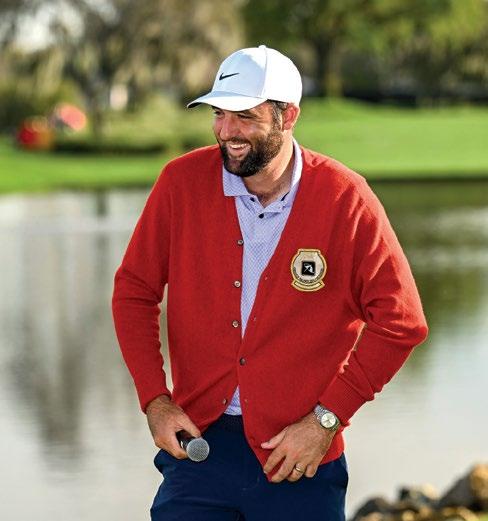





AD Palmer has researched extensively to curate an authentic representation of Palmer’s sense of style. Says Amy Palmer Sanders, Palmer’s daughter and chair of the Arnold Palmer Group, “The AD Palmer Collection reflects my father’s own approach to style and to life, with quality craftsmanship and straightforward design.”
The brand’s debut collection for spring 2024 features the Pembroke Sweater (above right), made from a merino-silk blend.
ISSUE 60—KINGDOM— 071




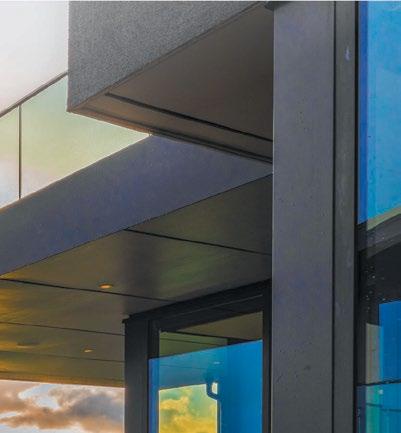


Majors & Minors

Even in a fractured sport, four championships remain the pinnacle of achievement in professional golf—and a means of binding together its disparate strands. But do the majors now routinely favor the elite, or have they become a lottery open to all? Paul Trow takes us on a grand tour of the Big 4 in 2024, from the preeminent players to watch, the sleepers to keep an eye on and the storylines to follow.
ISSUE 60—KINGDOM— 073
2024 MAJORS PREVIEW
Scottie Scheffler is riding a March victory at the Players Championship at TPC Sawgrass into majors season.

074 —KINGDOM—ISSUE 60

Brian Harman and Wyndham Clark were not expected to win the Open championships of the British Isles and United States in 2023. To suggest, however, that the reigning champions went into their lifechanging weeks as underdogs would not be entirely fair. Just a month before his U.S. Open triumph, Clark posted an impressive maiden victory in the Wells Fargo Championship, showing the elite field a clean pair of heels. And left-hander Harman had averaged a top-10 finish every seven tournaments throughout his consistent, decade-long PGA Tour career.
“Life is better as a major champion,” said Harman last year, as his new status sunk in. “It’s been a wild ride, man. I’ve kept the Claret Jug on top of our kitchen counter. I’ve caught myself walking by it, looking at it, and I still can’t believe it happened.”
Majors - Setting Scene
The wins by Harman and Clark, at Royal Liverpool Golf Club and Los Angeles Country Club, respectively, obliged the big beasts in the post–Tiger Woods era— Scottie Scheffler, Rory McIlroy, Jordan Spieth, Justin Thomas, Jon Rahm and Brooks Koepka—to share just two of the four most sought-after baubles. Rahm’s triumph for the ages in the Masters embellished the wonderful Spanish tradition at Augusta National, following in the footsteps of compatriots Seve Ballesteros, José María Olazábal and Sergio García. The star whom Rahm eclipsed during the gripping final-round showdown, Koepka, gained his revenge a month later by picking up his fifth major title, at the PGA Championship at Oak Hill Country Club in upstate New York.
The fact that Koepka and now Rahm are embedded in the LIV camp while the other four heavyweights have remained with the PGA Tour is not without significance. Rahm and Koepka can both be expected to challenge again at the majors, and their fellow LIV renegades who are exempt into all four of the 2024 championships—namely Bryson DeChambeau, Dustin Johnson, Cameron Smith and Phil Mickelson—will also be looking to prove themselves on the premier stages.
As the early 2024 PGA Tour season has shown us, however, there are a host of other players who are perfectly capable of putting their hands up on any given week. These are golfers who might not appear high on the bookies’ odds but who will take their chances if their putters start to work, as Harman’s did so memorably at Hoylake last summer.
ISSUE 60—KINGDOM— 075
Jon Rahm plays his tee shot on the 18th hole during the final round of the 2023 Masters.

Majors - Setting Scene
“Life is better as a major champion. It’s been a wild ride.”
— Brian Harman
Still, the six aforementioned “beasts” remain the men to beat in 2024. Collectively, they boast a haul of 17 major wins between them (just two more than the 15 accumulated by Woods, who seems unlikely to figure prominently this year, and one fewer than Jack Nicklaus’s career total). Scheffler has been World No.1 for a while now and is by general consent, backed up by statistical proof, the outstanding ball striker in the game. He routinely reeled off top-10 finishes while still finishing near the bottom of the field most weeks for putting prowess in 2023, although the Texan showed form on the greens—an ominous sign for his rivals—in winning the Arnold Palmer Invitational and Players Championship in March.
McIlroy suggested a switch to a mallet putter might help Scheffler fix his problems on the greens, and
whether it is down to McIlroy’s advice or not, that is exactly what Scheffler did at Bay Hill. McIlroy, for his part, will continue his pursuit of a cherished fifth major after 10 barren years during which he has come so close so often. He has also, periodically, been the victim of putting woes, and despite the smoothness of his current stroke, he needs to prove it can propel him across the finish line without a wobble when it really counts.
Soon to turn 35, the Ulsterman remains the longest driver on tour, which gives him a huge advantage on daunting major layouts. The flipside is that it can trigger a recurring weakness when trying to hit the ball too hard under pressure, leading to the occasional destructive snap-hook. As recently as January, he gifted the inaugural Dubai Invitational to England’s Tommy Fleetwood with precisely this blemish off the final tee, while holding a one-shot lead. Still, his record of 30 top-10s in 59 major appearances puts him second only to Woods among contemporary players, so he can be expected to keep knocking on the door for a while yet.
McIlroy’s primary focus will be on claiming, at last, the one major to have eluded him, at Augusta, in April. Like McIlroy, Spieth needs one specific victory to join the inner sanctum of players to have won all
076 —KINGDOM—ISSUE 60


four of the modern majors (Gene Sarazen, Ben Hogan, Gary Player, Nicklaus and Woods). In his case, though, the target will be the PGA Championship at Valhalla, in Louisville, Kentucky, a course that might prove too long and bunker-strewn for the likable Texan but offers plenty of scope for his imaginative putting skills.
Thomas, after two years of erratic form, would cherish completing a hat trick of PGA Championship titles in May, having previously won the Wanamaker Trophy in 2017 and 2022. But his chances are no stronger than those of the next few cabs in line.
Of those in the top 50 who have previously scaled the heights, Colin Morikawa, winner of the 2020 PGA Championship and 2021 Open, stands out as someone who could rise to the challenge at any given moment. So, too, could Hideki Matsuyama, Jason Day, Matt Fitzpatick and Shane Lowry, all recent champions, or Adam Scott, Justin Rose, Lucas Glover and Keegan Bradley, still competitive more than a decade after their major triumphs.
Majors - Setting Scene
But it is rare for a year to pass without at least one of the majors being claimed by a first-time winner. It could be a dazzling youngster like Tom Kim, Will Zalatoris, Cameron Young or Ludwig Åberg, or maybe even the recent American Express winner, Nick Dunlap. Or it could be one of a more experienced group amongst the higher rankings—think Fleetwood, Viktor Hovland, Max Homa, Xander Schauffele and Patrick Cantlay.
The latter two, seemingly best pals, have certainly paid their dues, and a victory for either, or both, would hardly be a shock. Schauffele, in particular, is close, having already recorded 11 top-10s in his 26 starts in the majors to date.
Cantlay is perhaps the most curious case. A steely competitor and winner of eight PGA Tour titles, he has managed only four top-10s in 27 major starts and has never, realistically, been in serious contention. But his displays in the last two Ryder Cups suggest he has what it takes to get the job done if given the chance. He is deadpan and feisty in equal measure, and his refusal to wear a cap last year in the Ryder Cup sparked considerable controversy.
It would be fascinating to see how Cantlay handles being in the lead coming down the stretch in a major championship. To be in contention, as the Sunday sun sets, remains golf’s ultimate challenge. There is nowhere to hide, and as Harman suggests, it can be a wild ride.
ISSUE 60—KINGDOM— 077
Brian Harman’s moment of glory at Royal Liverpool last July (opposite). Tommy Fleetwood (top) won the Dubai Invitational, and Patrick Cantlay (above) shone in the 2023 Ryder Cup for the United States.
APRIL 11–14


The biggest issue prior to the 88th Masters is which breakaway LIV golfers have received invitations to make the most famous slow drive in the sport, down the swept and shady Magnolia Lane. Chile’s Joaquin Niemann, the 25-year-old winner of two LIV Golf titles in 2024 already, received his invitation in February—seemingly out of the blue—which makes him, at the time of going to print, the first and only LIV golfer to be invited to play in the Masters who is not already exempt.
Majors - Setting Scene
status in the top 50, along with three recent major winners (Brooks Koepka, Cameron Smith and Bryson DeChambeau). Left outside Augusta’s secure gates will be Talor Gooch, Louis Oosthuizen and Abraham Ancer, who all have the ability to win the Masters.
Qualification for the Masters is predicated largely by players’ positions on the Official World Golf Ranking, but because no ranking points are awarded to LIV tournaments, regardless of the quality of individual performances, many otherwise deserving golfers have tumbled out of qualification.
The result of sticking to the status quo—bar Niemann’s invitation—is that any claim that this year’s field represents the entire elite of the game, coming together to do battle with one another in time-honored tradition, is stretching the truth. LIV boasts seven Green Jacket recipients (by definition, exempt for life): defending champion Jon Rahm, Phil Mickelson, Dustin Johnson, Patrick Reed, Sergio García, Bubba Watson and Charl Schwartzel. In addition, Tyrrell Hatton and Adrian Meronk still qualify via their
Masters chairman Fred Ridley is acutely aware of the problem but appears to be playing a waiting game. “If you look back over the history of the Masters Tournament and the qualifications that existed, we have changed those qualifications dozens of times,” he said. “We look at those every year. We don’t make changes every year, but we do look at them under the current circumstances.”
The current situation cannot last too much longer, though with reconciliation talks between the PGA Tour and the Saudi Arabian Public Investment Fund seemingly in the doldrums, it is unlikely to be resolved in time for any of this year’s majors.
Meanwhile, preparations for the 2024 Masters are already well underway. Last year, Augusta National was stretched to 7,510 yards, due mainly to an extension to the par-5 13th, and the only adjustment this time has been moving the tee at the downhill par-5 2nd slightly to the left and back 10 yards. Already the longest hole on the course, it will now measure 585 yards.
078 —KINGDOM—ISSUE 60
THE MASTERS


Valhalla was the great hall of Norse mythology, where the souls of brave Viking warriors banqueted with the gods. e golf club of the same name, in Louisville, Kentucky, has appropriately witnessed a few feasts of its own during its brief existence.
Majors - Setting Scene
pin locations. e front nine crosses a valley, while the inward half is carved out of higher, tree-covered terrain with a shallow creek that comes into play on four holes.
In the mid-1980s, Dwight Gahm engaged Jack Nicklaus to create a championship course across 486 acres of rolling terrain he owned, 20 miles east of the city center. Valhalla has since hosted three PGA Championships and the Ryder Cup, beginning with the 1996 PGA.
e PGA had purchased 25 percent of the club, and a er Mark Brooks’ playo victory over local hero Kenny Perry in ’96, that stake was extended to 50 percent. e championship swi ly returned in 2000, and at the conclusion of that event, won by Tiger Woods in a playo against Bob May, the PGA exercised an option to purchase the club outright. It remained the sole owner until 2022, when it sold out to a consortium of wealthy local members.
During construction, 650,000 cubic yards of earth were moved to build tees, greens and fairways up to a level that would protect them from storm damage. e greens thus became naturally slick and featured distinct tiers with a variety of challenging
Before staging its third PGA Championship, in 2014—a triumph in the gloaming for Rory McIlroy— Valhalla also hosted the Senior PGA Championship in 2004 and 2011, won respectively by Hale Irwin and Tom Watson. But its greatest, and most hazardous, exposure to the wider world came with the 2008 Ryder Cup.
In addition to the introduction of four new greens, several extra bunkers and 200 yards in length, Mother Nature made her own sweeping changes when Hurricane Ike ripped through Louisville the weekend beforehand. e storm in icted widespread destruction on the local community, while on the course, 17 large trees were uprooted, ag poles bent double, corporate hospitality tents decimated and TV towers blown over.
anks to the herculean e orts of city workers and volunteers, the match still took place as scheduled. With it, Paul Azinger’s American team reversed a run of three defeats by trouncing Sir Nick Faldo’s sluggish Europeans 16½-11½.
ISSUE 60—KINGDOM— 079 PGA CHAMPIONSHIP
MAY 16–19
The Green Jacket of Augusta National (far left); Augusta’s hallowed “Amen Corner” (left); Rory McIlroy clinches his last major title, at Valhalla in 2014 (right).
Photo: Drone 30 Media



Framed by winding creeks and far-reaching salt marshes, The Retreat is the final and most spectacular neighborhood in Charleston’s island town. Connected to the “mainland” of Daniel Island and minutes from the Fazio and Jones courses of the private Daniel Island Club, The Retreat will be home to just 62 fortunate families. An o ering of these incomparable homesites is planned this fall. Visit TheRetreatDI.com to learn more.


Equal Housing Opportunity. This does not constitute an o er to sell or a solicitation to buy, real estate to residents of any state or jurisdiction where prohibited by law, or where prior registration is required, but has not yet been fulfilled. A Town. An Island. A Way of Life.

Majors - Setting Scene
The No. 2 Course at Pinehurst Resort in the North Carolina Sandhills was created in 1907 by Donald Ross. The pride and joy of this émigré Scot’s celebrated career, which spawned more than 400 layouts during the early part of the 20th century, it remained a work in progress throughout the final four decades of his life. The expertise Ross acquired as an apprentice professional and greenskeeper in Dornoch, his whiskyingrained hometown in northeast Scotland, is distilled into this masterpiece, now regarded as the ultimate showcase of his links-influenced design skills.
Trademark turtleback greens with treacherous run-off swales, that punish any approach not struck with pinpoint accuracy, will surely be a talking point throughout the Open. But so, too, will the ubiquitous sandy waste areas flanked by hardpan, pine straw, native scrub, wiregrass and longleaf conifers that define much of the course’s strategic challenge. These features were reemphasized by Ben Crenshaw and Bill Coore with their 2011 redesign, inspired by aerial photographs of the course as it was during Ross’s lifetime. As a result, they reversed

many of the changes made by Robert Trent Jones Sr. in 1974, when Bermuda grass and thick rough were introduced.
No. 2’s first major, the PGA Championship of 1936, was won by Denny Shute, who beat Jimmy Thomson 3&2 in the final. Post-war, apart from staging the Ryder Cup in 1951, the course endured a barren spell before finally hosting its second major, the 1999 U.S. Open. This proved to be the last hurrah for Payne Stewart, who tragically died a few months later in a plane crash. However, his memory lives on at Pinehurst thanks to a statue beside the 18th green marking his moment of victory.
Two other Opens—won by New Zealander Michael Campbell (2005) and Germany’s Martin Kaymer (2014)—have followed, and four more (2029, 2035, 2041 and 2047) are already inked in after this year’s championship. The USGA’s enduring faith is only part of Pinehurst’s success story. Whatever the economy has thrown at it over the years, the resort just keeps growing, including this April, with the opening of its No. 10 course, designed by Tom Doak.
ISSUE 60—KINGDOM— 081 U.S. OPEN JUNE 13–16
The verdant fairway, sandy waste areas and raised green on the 7th hole are classic Pinehurst No. 2 (far left); Payne Stewart celebrates his momentous victory in 1999.


Royal Troon, on the Ayrshire coast, west of Glasgow and just north of Prestwick, will host The Open for the 10th time this summer. The cornerstone of a public links complex, which also includes the 18-hole Portland and nine-hole Craigend layouts, Royal Troon began life with just five holes in 1878. The full 18 holes, designed jointly by 1882 Open champion Willie Fernie and club professional George Strath, opened 10 years later, and the ‘royal’ designation was conferred upon its centenary in 1978.
Majors - Setting Scene
by the 14th on the Old Course at St Andrews and the 15th at Royal Liverpool, but the 8th is still the shortest at 123 yards. Known as the Postage Stamp, it came to prominence during the 1973 Open when Gene Sarazen, then aged 71, holed in one in the first round and followed up the next day by holing out for a two from one of the five greenside bunkers.
After an upgrade from five-time champion James Braid, the course staged its first Open in 1923 (won by Englishman Arthur Havers)—and little has changed since. It is a classic out-and-back links, measuring well over 7,000 yards from the tips, but, as with most Open venues, line is more important than distance. There are a plethora of bunkers, many not visible from the tees, phalanxes of deep rough and a smattering of gorse and broom. A good score is generally made on the gentler outward half, where the views across the Firth of Clyde on a clear day can take the breath away. The inward holes, often playing into the prevailing northwesterly wind, are much sterner.
For many years, Royal Troon boasted the longest and shortest holes on the Open roster. The 601-yard sixth is no longer the longest, having been overtaken
The second Open at Troon, in 1950, was won by South Africa’s Bobby Locke, and since then golf’s oldest major has returned at least once every decade. Arnold Palmer’s second Open triumph, in 1962, was significant both for the King’s imperious play that week and for the crowds that flocked to Troon, many of them gatecrashing from the beach.
This was the first of six consecutive Open successes by Americans at Troon: Tom Weiskopf (1973), Tom Watson (1982), Mark Calcavecchia (1989), Justin Leonard (1997) and Todd Hamilton (2004) followed. That run was only broken in 2016 by Sweden’s Henrik Stenson, who survived an epic shoot-out against Phil Mickelson with a closing 63.
As it closes out the 2024 major schedule, Royal Troon should once again serve as a classic stage for epic battles. Whether those battles are between the sport’s biggest names or obscure up-and-comers, we shall soon see.
082 —KINGDOM—ISSUE 60
OPEN
18–21
THE
JULY
From left: Sam Snead, Jack Nicklaus, Bob Charles and Arnold Palmer practice ahead of The Open at Troon in 1962; the Claret Jug on the 8th tee at Troon.


















JOIN OUR MISSION TO CHANGE THEIR FUTURE.
OUR SUCCESSFUL GOLF TOURNAMENTS ARE LED BY PASSIONATE INDIVIDUALS WHO GENEROUSLY INVEST THEIR TIME, TALENTS AND ENERGY.
Folds of Honor provides educational scholarships to the spouses and children of fallen or disabled American service members and first responders. When you host an event, you turn an educational dream into reality. Please scan the QR code below to learn more about the areas related to leading a Folds of Honor activity in your community. Together, we can make a generational di erence for those who stand guard over our freedom.



LEARN MORE ABOUT HOW TO GET INVOLVED






FOLDSOFHONOR.ORG HEATH EKSTRON // PGA
★ ★ ★

GOLF FEATURE Xxxxxxxxxa
The Scenic R ute

Two years ago, at the 150th Open at St Andrews, a dream came true for Max Homa when he was drawn to play with his childhood hero, Tiger Woods, for the first time.
“I was shaking like a leaf on the first hole,” admits Homa, speaking exclusively to Kingdom magazine earlier this year. “It was a weird day, because we had something like a six-hour round. It was the slowest round of my life. Matt Fitzpatrick was also in our group, and he and I get along really well, and Matt said that if we had been playing with anyone else, we would have been complaining all day. But because we were playing with Tiger, it was actually nice to be out there with him for so long.”
Majors Profile - Max Homa
Stardom beckoned when Max Homa, NCAA champion and Walker Cup player, turned professional in 2013. It took longer than many expected, but the California native is now ranked in the world’s top 10—and he appreciates every second of his success. Homa spoke to Robin Barwick.
For Woods, the 2022 Open became a 36-hole exercise in frustration and pain, as he limped his way around the Old Course for two days before missing the cut. Twice, in The Opens of 2000 and 2005, Woods had been peerless at the “Home of Golf,” and at the close of his second round in 2022, it got emotional. Homa and Fitzpatrick—the latter of whom had been crowned U.S. Open champion weeks before—were close by to witness a massive St Andrews crowd give Woods a standing ovation on the 18th hole. Woods stood on the Swilcan Bridge and raised his cap. His two playing partners stayed a few paces back, as the former champ bowed out of an Open at St Andrews, almost certainly for the last time.
The moment was particularly poignant for Homa, who grew up in Valencia, California. “We used to go to the L.A. Open,” recalls the now 33-year-old golfer, who was six when Woods transformed golf with his first major title at the 1997 Masters. “I had a hat that I would bring every year for autographs. I filled that thing up as best I could—it had no room on it in the end. I tried my damnedest to get Tiger’s autograph for, gosh, so many years, but I never got it. It was a tough autograph to get.”
ISSUE 60—KINGDOM— 085
Max Homa plays out of the notorious Road Hole bunker during the 2022 Open at St Andrews.

Majors Profile - Max Homa
At St Andrews, Homa belatedly got the signature he most wanted—not on his cap but on his scorecard. More memorable, however, was a conversation the pair had on the ninth fairway. “Tiger came up and asked me how many tour events I had won,” recalls Homa, who had won four times on the PGA Tour at that point, including the 2021 Genesis Invitational (previously known as the L.A. Open, where Homa hunted autographs), where he was presented with the trophy from tournament host Woods.
“I made some little joke about how I only needed another 78 wins to catch him, and very seriously, Tiger said that I should win a lot more tournaments. I kind of giggled, and he said it again, and I have kept that in my head. If the GOAT thinks I am underachieving, then I should probably have a little more confidence in myself.”
As the 2024 majors loom, there is no question that Homa belongs in contention. He now has six PGA Tour wins to his name—only 76 behind Woods now—but for a player of his caliber, his majors record is undercooked, with just one top-10 finish so far. Still, Homa’s coach, Englishman Mark Blackburn, says the former NCAA champion with the University
“If the GOAT thinks I am underachieving, then I should probably have a little more confidence in myself.”
—Max Homa
of California, Berkeley, is built for winning majors on tough golf courses due to his mental toughness and calmness.
“I pay Mark a lot of money to say those kinds of things!” jokes Homa, whose witty one-liners have earned him 640,000 followers on X. “I have not really shown it yet, but once I get out of my own way and let myself play golf like I do in regular tour events, I have a well-rounded game that fits most of those hard majors golf courses. I know I am really good at dealing with the pressure on Saturdays and Sundays. Some people struggle when they get into the mix, but I struggle to get into the mix in the first place. I have been thinking

086 —KINGDOM—ISSUE 60
Homa and caddie Joe Greiner chat with Tiger Woods at St Andrews in 2022 (left); Homa tees off on 18 at the Old Course (right); Woods salutes the crowd at St Andrews while Matthew Fitzpatrick and Homa look on (bottom right).


about it a lot lately. It’s like, I have a plan of how the week is going to go, and then I get punched in the mouth on the Thursday, and my alarm bells seem to go off a lot too fast.
“I need to do a better job of not panicking about anything, and just play golf as it comes,” he continues. “Look at Jon Rahm last year at the Masters: He won after having a four-putt at the first hole. It’s that kind of thing that I have been terrible at, and what I am hoping to be better at.”
Homa talks in unvarnished truths, and he is selfdeprecating, which makes him instantly likable. As a professional athlete, however, his stark honesty can be self-obstructive, too. As Homa says, he needs to get out of his own way.
Majors Profile - Max Homa
During his early years as a professional, Homa encountered most of his problems off the tee. His inconsistency resulted in a five-year spell bouncing between missed opportunities on the PGA Tour and rebuilding on the secondary Korn Ferry Tour. In 2017, he missed the cut in 15 out of 17 PGA Tour starts.
“I understand that people have been in lower places, and I don’t mean to demean that, but 2017 was my worst season by a mile,” says Homa, who lost playing status to the extent that he traveled to an Adams Pro Tour event at Brownwood Country Club, 170 miles west of Dallas. “It was the middle of nowhere. I remember sitting in a hotel room by myself, with very little Wi-Fi or phone service. I did a lot of thinking, and I was highly motivated to not be in that position anymore.”
Homa was paired that week with a local club pro, who asked him what he did for a living. “I said that I had played on the PGA Tour that year,” says Homa, who turned pro in 2013 and won on the PGA Tour for the first time in 2019. “That was not the most fun feeling, to be playing in this mini-tour event, halfway across the country from where I lived, because I had lost all of my playing status.”
To make it worse, Homa shot 69-71 and missed the cut by three shots. All that way for two competition rounds and nil dollars in return.
ISSUE 60—KINGDOM— 087

“You’ve just got to put one foot in front of the other and get to work, and hopefully something clicks. I am thankful that it did.”
—Max Homa
“But that is kind of the fun of this job in a way,” he reflects. “Nobody has a linear career if you look at guys on tour—although Jon Rahm has probably had the closest thing to linear, but even Jon would probably say that he had hit a bunch of speed bumps along the way.
Majors Profile - Max Homa
“It is easier to look back on that week in Texas now than it was to be living it at the time,” he continues. “You’ve just got to put one foot in front of the other and get to work, and hopefully something clicks. I am thankful that it did.”
Vista Valencia
As it happens, Homa’s history of starting badly dates right back to his first ever competitive golf shot, when he was six, in a father-son scramble on the par-3 course at Vista Valencia.
“They had great junior events on the par-3 course,” starts Homa. “I was pretty nervous, and I was taking a practice swing, and I hit the ball with the toe of the club. The ball went about 20 yards dead right. That was my first ever competitive golf shot. It was very embarrassing. I remember that I felt like crying, but as it was a scramble, my dad got to tee off for us as well.”
The Homa family moved to Valencia, just north of Los Angeles, when he was three years old, and the 27-hole, public Vista Valencia Golf Course, on Trevino Drive, became Homa’s home away from home.
“Vista Valencia is still one of my favorite places to go,” he says. “It is a par-61 golf course with a massive driving range that is lit up at night. Back in the day, they had a fantastic junior rate, so you could play the par-3 course as many times as you like for $1. The club was definitely tailored for kids and inclusivity. If you went there right now, even if it is raining, I bet the range would be pretty darn full. We would just go there and hang out, and there were so many kids that it had a summer camp–type feel, but all the time.”
Also growing up at Vista Valencia was a kid called Joe Greiner, four years older than Homa, and who is now Homa’s caddie.
“I will say this as a fact: Joe Greiner taught me how to gamble,” Homa says with a laugh. “He taught me how to hustle a little bit; some of it was direct and some was from watching him, and this was life at Vista Valencia. Joe and this other kid, Brandon Christianson—who is now the head golf coach at Cal State Stanislaus—were the best two golfers I had ever seen. It was inspiring to be around them, and us younger kids thought they would be the next Tiger Woods. They were incredibly good at golf. I think about it all the time, and it is pretty darn special to have somebody who I grew up with at the same club, and that we are still somehow in the golf world together.”
Homa is ranked 8th in the world as this story goes to press, and he has worn red, white and blue in the Presidents Cup and Ryder Cup. Taking the “scenic” route to the top explains why he did not get the chance to walk the fairways with Woods until he was 31. It also explains why Woods’s words meant so much to Homa. Maybe he will win a major title, maybe not, but you can’t help hoping that he does.
088 —KINGDOM—ISSUE 60
Homa starred for an underachieving U.S. Ryder Cup team last year, posting 31/2 points.
Experience Dormie Network


Dormie Network

An experience you won’t soon forget.
In the midst of your round, as you stroll from tee to the impeccably maintained fairway alongside your colleagues, a revelation unfolds: this is more than just a game. It’s an opportunity to connect, to forge relationships that transcend the typical boardroom boundaries. Here, amidst stunning landscapes and unparalleled service, every shot, every conversation is a chance to strengthen bonds. Discover an experience where business, pleasure, and the spirit of the game converge to create unforgettable moments.
Get on the list at dormienetwork.com/kingdom-magazine
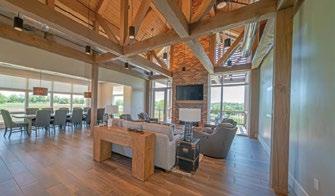
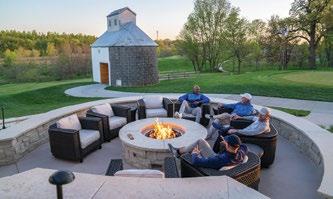
Where every club is your home club.
Nebraska City, Nebraska Roanoke, Virginia San Antonio, Texas West End, North Carolina Egg Harbor Township, New Jersey Maxwell, Nebraska Victoria National® Newburgh, Indiana
 Wyndham Clark holds aloft the U.S. Open trophy at Los Angeles Country Club, June 18, 2023.
Wyndham Clark holds aloft the U.S. Open trophy at Los Angeles Country Club, June 18, 2023.
Wyndham’s Winding Road
Wyndham Clark has come a long way in 12 months. A year ago, he had not won on the PGA Tour, and he did not get invited to the Masters. Now, he is a multiple PGA Tour winner, major champion, Ryder Cup golfer and Augusta-bound. Robin Barwick spoke to Clark and his caddie, John Ellis, about a dramatic coming of age.
‘Oh my gosh, how crazy is that?’ ”
Majors Profile - W Clark
Not all that crazy, it turns out. Clark, now 30, was not among the popular pre-championship favorites last June, but he had won the Wells Fargo Championship a month before at Quail Hollow—his first PGA Tour victory—and his confidence was sky-high.
“Winning the Wells Fargo gave Wyndham the comfort to go and win the U.S. Open,” says Ellis, who has caddied for Clark since he joined the PGA Tour in 2018. “There is no substitute for winning. It allowed Wyndham to be calmer and to play with more freedom, and not to shy away from big moments.”
A week before Wyndham Clark won the 2023 U.S. Open at Los Angeles Country Club, he visited the exclusive parcel in Beverly Hills to play the course before the crowds and major-championship tensions descended. Clark’s caddie, John Ellis, texted to ask how it went.
“The course is amazing, perfect for us, we’re going to win the U.S. Open,” Clark texted back.
“We don’t need to show up until Thursday,” he joked. “I have the course figured out.”
Lighthearted as it was, Clark’s response proved prescient. “The day after we won, John said, ‘Do you remember texting me that we were going to win?’ I said, ‘I did?’ John showed me the texts, and I was like,
The course also made Clark feel at home. “I just felt really good there from the start,” he explains. “The tee shots fit my eye, I love the course design and the topography, and the greens were amazing. I thought everything about it was awesome.”
Despite his high level of comfort at LACC—and opening the championship with a sizzling 64—Clark struggled to close out the U.S. Open. He was in the final pair with California-born Rickie Fowler for the final round, who was also striving for a first major success, while Rory McIlroy, the popular Irishman, was searching for his first major win in nine years, in the group ahead. Many in the crowd treated Clark as if he were just along for the ride, cheering for his more famous rivals and even calling for Clark’s putts to miss.
ISSUE 60—KINGDOM— 091


Majors Profile - W Clark
In the end, however, Fowler slumped to a finalround 75, McIlroy’s putter ran cold down the final stretch, and they were out-lasted by the outsider, who closed with a level-par 70 to edge McIlroy by a shot.
Ellis has played a key role in helping Clark reach the top of the world game, ever since the pair met at the University of Oregon in 2016. At the time, both men needed a restart. Denver-born Clark had transferred from Oklahoma State after his college career had begun to wane, while he struggled to come to terms with the loss of his mother, Lise, who died of breast cancer when he was 19. Ellis joined Oregon as assistant coach to Casey Martin soon afterwards, also looking for a fresh challenge after his own tour career had faltered.
“Having just come off tour, John was playing at a really high level,” recalls Clark (who, incidentally, played high school basketball with 49ers running back Christian McCaffrey, at Valor Christian in Highlands Ranch, Colorado). “John and I would play a lot, and while I would beat the rest of the guys on the team consistently, John would then beat me. I would shoot a 67 or 68, beat the other guys and think that was a great score, but then John would shoot 64 or 65. He would
“I had heard about this hotshot kid coming in from Oklahoma who was all-world this and that.”
—John Ellis
say, ‘I couldn’t make it on tour, so if you can’t beat me, how the heck are you going to make it out there?’
“John challenged me to dig deeper, he pushed me, and playing against him was a great barometer of where my game was. Throughout the fall semester, I hardly beat John, and then midway through the spring semester, I started to consistently beat him. Sure enough, I was winning college tournaments, and I was named Player of the Year, and it was because of the money games I played against John.”
“I had heard about this hotshot kid coming in from Oklahoma who was all-world this and that, but who was looking for a fresh start,” adds Ellis, 44. “Wyndham had the ability to be a superstar, but
092 —KINGDOM—ISSUE 60
Clark’s moment of glory, with caddie Ellis; Los Angeles CC, overlooking downtown L.A.












Located deep within the rocky, forested terrain of the Missouri Ozark Mountains, Big Cedar Lodge is a remote haven of natural beauty that brings conservation to life. connecting to the great outdoors.

Welcome to Nature Golf at Big Cedar Lodge.



Big Cedar
B I G C E D A R L O D G E B I G C E D A R . C O M R I D G E D A L E , M O
877.280.1295
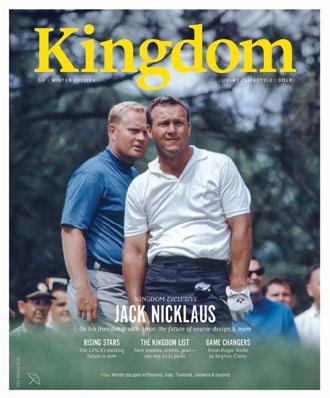



Kingdom.Golf KINGDOM.GOLF / KingdomGolf / KingdomMag / KingdomGolfMag Connect with Subscribe online To receive our free weekly newsletter with compelling stories and excellent offers visit: kingdom.golf/kingdom-newsletter

Majors Profile - W Clark
he didn’t quite know how to handle himself in all situations. There are very few guys, even on the PGA Tour, who can hit the ball 330 yards, and chip and putt like Wyndham does. Physically all the skills were there, but it has taken a while to complete the package.
“The thing about Wyndham is that he was not satisfied with being an okay golfer. He wanted to be great. He worked really hard, and I loved that. He works his tail off to this day. His hunger and desire have not changed at all.”
When Ellis asked Clark not to make the same mistakes that Ellis had made as a professional, the advice resonated.
“I failed on tour because I made excuses, and I blamed others, and I failed to address my attitude,” explains Ellis, “and Wyndham was heading towards that path. I told him to do the opposite. There are so many highs and lows in golf, and you can swing from one to the other really fast, but we try to stay more neutral, day in, day out.”
Adds Clark, “The mental side has always been a challenge. It is still a work in progress, and John and I
are constantly working on it. John can get in my face and say, ‘Hey, get your act together, we need to finish this round.’ Sometimes I can get in my own head, and John is really good at calling me out and getting me back on track.”
Famous First Tee
When their son was 11, Clark’s parents scraped together the money to pay for a membership at the prestigious Cherry Hills Country Club. Regular Kingdom readers will know that Cherry Hills is where this magazine’s founder, Arnold Palmer, enjoyed what is arguably his most famous day, when he won the 1960 U.S. Open, despite beginning the final round seven shots off the lead.
“I give Cherry Hills a lot of credit for helping me reach tour-level golf,” says Clark, who is paying thanks to the club by giving it a replica of his U.S. Open trophy. “It is a world-class golf course, and there were a bunch of really good junior golfers there. Until I was 11, I had played at a public range, so to move to a country club where I could hit unlimited golf balls, that was
ISSUE 60—KINGDOM— 095
Clark plays his approach on the final hole of the 2023 U.S. Open.

my candy store. I no longer had to put money in a ball machine. I would say, ‘Dad, we have free golf balls!’ He would sigh and say, ‘Yeah, isn’t that great?’ ”
A 60 in the third round secured victory in the AT&T Pebble Beach Pro-Am, which was shortened to three rounds due to bad weather.
“I spent my childhood walking past that display in the clubhouse about 1960, hoping that I could win the U.S. Open one day.”
Majors Profile - W Clark
Clark grew up not only hitting as many golf balls as he could, but also appreciating the legend of Palmer and how he strode up to the first tee of that fateful final round in 1960—back then a par-4 playing 318 yards—and smashed his tee shot onto the green. It was a courageous shot, typical of Palmer, and it set up his victory charge.
“The tips are now further back, but we would always play the first hole from the Palmer tee, because it was fun to start a round by trying to drive the green,” says Clark. “I think I was 15 the first time I drove the green. It might have landed short and bounced to the fringe of the green but I counted that as driving the green. It was always a good feeling to birdie the first at Cherry Hills. Now when I go back, from that Palmer tee I have to hit a soft, cut 3-wood to reach the green. It is amazing how much farther we hit the ball with modern technology. The fact that Palmer drove the green in 1960 is pretty remarkable.
“Some say it was the greatest U.S. Open ever,” adds Clark, “given that Palmer, Hogan and Nicklaus
—Wyndham Clark
were all in contention.” Billy Casper wasn’t far off either, and Gary Player and Sam Snead were in the conversation until the final round.
“I really appreciate that I grew up at a place like Cherry Hills, and I have a lot of respect for Arnold Palmer and what he accomplished. It is surreal that I spent my childhood walking past that display in the clubhouse about 1960, hoping that I could win the U.S. Open one day, and that I eventually did it.”
Clark won’t be considered an outsider when he makes his Masters debut in April. He shot a courserecord 60, 12 under par, in the third round of the AT&T Pebble Beach Pro-Am in February, to set up his third win in 10 months. And that 60 looked like it might be a 58 for a while. His confidence is high, and as he has a couple games scheduled at Augusta National ahead of Masters week, caddie Ellis is likely to be checking his texts regularly.
096 —KINGDOM—ISSUE 60





GREAT LAKES. GREAT GOLF.
RIOT AT
Arnold Palmer ranked his four rounds played at the 1962 Open among the very best of his legendary career. His performance, however, was only part of the story during the tournament’s final round, when crowd chaos consumed the King and captured headlines worldwide. Robin Barwick visited Royal Troon to find out what happened on that particular Friday the 13th.
Majors Feature - Palmer at Troon
On July 14, 1962, the headline on the back page of Britain’s Daily Mail called it a “crowd riot.” e paper reported that Arnold Palmer, playing the nal hole of e Open at Troon the day before, “ran for his life.” It continued: “ e crowd, about 30,000 strong . . . engulfed him, tossing him and almost trampling him underfoot. Police rescued him and cleared a way for him to reach his ball on the green.”
e crowd size might have been exaggerated, but Palmer was certainly jostled as he won the Claret Jug for the second time, defeating Kel Nagle by six clear shots on Scotland’s west coast. Chaos reigned.
“Anyone who saw . . . the appalling state of disorder, when the behaviour of an enormous crowd towards Palmer and Nagle was discourteous in the extreme, will urge for a revision in stewarding methods,” wrote Donald Steel in e Sunday Telegraph, on July 15, 1962.
Steel was reporting on e Open for the second time, his debut being Palmer’s rst Open triumph in 1961 at Royal Birkdale. Today, at 86, and having enjoyed a heralded career as reporter and golf course architect, he re ects on being caught amid the rampage that day. “It made watching the nal pair quite di cult,” recalls Steel, who was enlisted to update the Old Course at Royal Troon years later. ( e club became ‘Royal Troon’ upon its centenary in 1978.) “If you wanted to see what was happening, you had no choice but to be part of this crowd. I was young, and it was ne for me, but it made it di cult for others.”
Local amateur Stewart Wilson quali ed for e Open in 1962, when he was 25 years old. He played in the rst two rounds but missed the cut—and kept a safe distance on the Friday, when the nal two rounds were played.
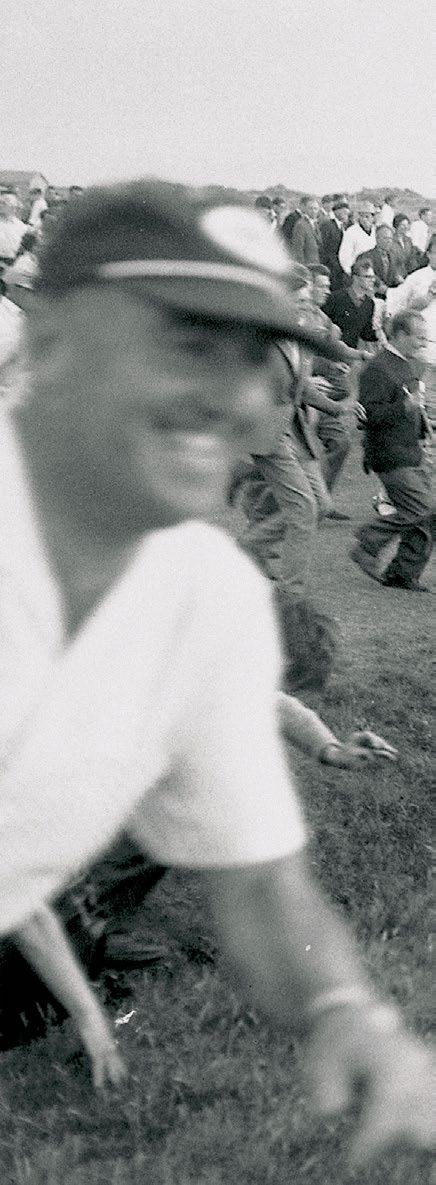

Standing in the center of this photograph, wearing a dark tie and holding a small flag, a steward is powerless as an exuberant crowd charges along the back nine at Troon, July 13, 1962.
098 —KINGDOM—ISSUE 60 MAJORS Troon 1962

ROYAL TROON
ISSUE 60—KINGDOM— 099
“Palmer even lost his shoe coming down the last hole when someone stepped on it,” recalls Wilson, a past club president of Royal Troon, over coffee in the clubhouse (with our every move observed by Palmer, from his portrait above the fireplace). “There was no crowd control. There were strings along the sides of the fairways, and there were stewards with wee flags, doing their best.”
Multiple factors led to the chaos of the 1962 Open, the first being Palmer’s magnetism. In the summer of ’62, Palmer was in his absolute prime as a golfer. Aged 32, he arrived in Troon as the winner of five major titles within the previous four years, and he was The Open’s reigning champ. With his strong, athletic build, the looks and smile of a Hollywood hero and charisma to match, he inspired even the oft-cynical media to swoon, sports fans even more so.
Reporting for the UK’s Guardian newspaper, Pat Ward-Thomas wrote at the time that Palmer possessed “that rare
blend of immense self-confidence and true modesty,” adding that he “remains a delightful, friendly human being who commands respect and affection.”
Palmer first traveled to Britain to play in The Open in 1960, when he lost by a stroke to Nagle. He returned in 1961 to win at Birkdale in a gale, and his dedication to The Open in the early sixties pushed the oldest of the four majors out of its post–World War II doldrums and into the international limelight.
“There is no question that Palmer was the driving force behind the growth of The Open,” says Wilson, who won the British Boys Championship in 1955. “I can’t stress too much how important it was for The Open that Arnold Palmer came over. That day at Troon, the people came to see Arnold Palmer.”
“He was a very, very good influence on The Open,” Steel adds. “He was just what the game needed, at the right time.”
The “right time” coincided with the fast evolution of outdoor broadcasting
and televised sports, and Palmer’s photogenic appeal and attacking brio brought golf from the fringes of professional sport and onto television screens around the globe. The sports fans of Scotland knew about Palmer— they had seen him on TV, and they knew that The Open at Troon was a rare opportunity to see a genuine sporting icon at his best. Right on cue, Palmer shot 69 in the second round on the Thursday, to carry a two-shot lead into the final day.
Then there was the weather. So often each July, The Open somehow turns summer into winter—as it had done with the storms at Birkdale in ’61, and with flooding at St Andrews in ’60. Yet in 1962, on this windswept stretch of Ayrshire coastline, sunshine lit The Open, the ground conditions were very firm, and so the prospect of watching the final day’s play was all the more tempting. Not only this, but the train station at Troon was a short walk from the golf course and received a regular service from Glasgow
Majors Feature - Palmer at Troon


100 —KINGDOM—ISSUE 60
The Old Course at Royal Troon and the beach, February 2024 (above); Troon’s famous par-3 8th, the “Postage Stamp” (right). Opposite page: The Palmer portrait at Royal Troon (left); Stewart Wilson, who played in the ‘62 Open, talks to Kingdom


Majors Feature - Palmer at Troon
“[They] walked from the station, along the shore and straight up onto the golf course, without paying.”
—Stewart Wilson
Central station, just 30 miles inland.
There was one more thing: The Open finished on a Friday (in keeping with tradition, to allow participating club professionals to return to their home clubs to serve their members on the Saturday), and July 13, 1962, coincided with the Glasgow Fair Fortnight. This was another annual tradition, instigated by the big factories and shipbuilders of the major industrial centers, when factories and ship-building yards would shut altogether for two weeks and allow vacation time to their workers all at once, to maximize efficiency. During the Glasgow Fair, with schools also closed, workers and their families would stream out of the city and usually head to the beach.
The Open’s organizers, the R&A, recorded an official total attendance of 37,098 for the 1962 Open, which would represent the tournament’s secondlargest attendance at the time (behind 39,563 at St Andrews in 1960). But the
figure likely represents the number of tickets sold and underestimates the size of the final-day rush.
“They came through the Aberdeen Gate,” offers Wilson with a mischievous smile, yet this claim requires explanation, because Aberdeen is 170 miles away, on Scotland’s east coast.
“Aberdeen people are thought to be tight,” chuckles Wilson, an inhabitant of Scotland’s west coast all his life, “so the Aberdeen Gate is how a lot of people got into the championship that day, having walked from the station, along the shore and straight up onto the golf course, without paying.”
Glaswegians poured through the Aberdeen Gate for the final day of the ’62 Open. The Glasgow Herald estimated a crowd of 15,000 for the day; the Mail claimed 30,000. We’ll never know. What we do know is that the fairway strings and stewards with “wee flags” never stood a chance.
ISSUE 60—KINGDOM— 101
The Open was caught completely unprepared, prompting Palmer to admit later to reporters, “I’ve never seen anything to compare to this anywhere in the world. It was frightening at times.”
Two years later, in his book entitled Portrait of a Professional Golfer (which was in fact a self-portrait), Palmer wrote on the ’62 Open: “Gallery control in Britain isn’t anywhere near as tight as it is in most major tournaments at home. There were some real stampedes.”
Ward-Thomas blasted in The Guardian that it had been a “disgusting exhibition by a huge stampeding crowd. Never has one seen such a revolting disregard for stewards and police. The whole conception of stewarding must be reviewed. It was pathetically inadequate for crowds that behave in this manner.”
He concluded: “Palmer’s presence these past three years has brought greatness once more to the old championship . . . Now the organization of the championship must match the quality of a great champion.”

Majors Feature - Palmer at Troon
Troon’s greens may have been trampled that day, the fairway strings snapped, but no serious injuries were reported, and no deaths. And a year later, at Royal Lytham & St. Anne’s, Palmer was off his game, golf course access was easier to control, and decorum was restored. The chaos of July 13, 1962, was a one-off, and when The Open returns to Troon this July, the Aberdeen Gate will be bolted shut.
“The organization of the championship must match the quality of a great champion.”
—Pat Ward-Thomas
Champions’ Retreat
Jack Nicklaus made his debut in The Open in 1962 but failed to make the halfway cut, having carded a 10 on Troon’s treacherous 11th hole. The American stayed at the hotel right next to the golf course, which today is called the Marine Troon, and the window from his hotel room gave Nicklaus the perfect vantage point to watch Palmer seal his victory.
“Arnold romped home,” Nicklaus would write in his autobiography, My Story, “amid a frequently out of control ‘army’ of golf-crazed Scots.”
Palmer stayed at the Marine Troon, too, and enjoyed a celebratory dinner in the hotel restaurant that evening that was topped off when the staff presented him with a cake bearing the words “Worthy Champion.”
Now part of the Marine & Lawn Hotels & Resorts Collection, the Marine Lawn remains a landmark in Troon, with views over the first and 18th holes of the Old Course at Royal Troon and beyond, across the Firth of Clyde and the Isle of Arran. The Marine Troon is the ideal base from which traveling golfers can explore the famous Ayrshire links of Troon, Prestwick and Turnberry, among many more, and we recommend drinks in the hotel’s Seal Bar (see “Major Mixology,” page 132).
102 —KINGDOM—ISSUE 60
Palmer plays out of a bunker by the 17th green at Troon in 1962. Visible in the photograph’s top-right corner is the Marine Troon hotel.





AP Tea









THE NEW MATCHMAKERS


Golf courses built specifically for match play are debuting at prestigious resorts. Do they represent the future of design? Shaun Tolson squares off to find out.


104 —KINGDOM—ISSUE 60

During our first day on property at PGA National Resort, in Palm Beach Gardens, Fla., my buddy and I are seven holes into a spirited contest on the Match course, a layout conceived by Andy Staples that opened for play a couple of years ago. As we approach the eighth hole, I’m two up and feeling confident, but my friend has a stroke in hand, so anything is possible.
Golf Travel - Match Play
As the winner of the last hole, I have a decision to make: Where are we going to tee off? This isn’t a one-off wrinkle that’s unique to our match; it’s an intentional attribute of the course’s design. Each hole features flowing tee areas. Some extend in straight lines. Others meander around creeks and ponds. Occasionally, these ribbonlike teeing grounds even trundle over subtle mounds, introducing the prospect of having to hit from a side-hill lie. These tee boxes, which can affect the length of some holes by more than 220 yards, are an integral aspect of the course’s identity, adding an extra element of strategy to a golf match with layouts that can be customized as you go.
Staring down the eighth fairway—one that’s flanked by a channel of water running down the entire right side—I ultimately pick out a spot on the tee box that positions the flagstick 295 yards away. That makes the hole drivable for me but not for my friend, potentially negating the stroke that I’m giving him.
Such strategic moves are exactly what the Match’s designer wanted the course to inspire. “A lot of golfers have played their entire lives and never experienced golf in that setting,” Staples explains. “When they actually get exposed to it, they say, ‘This is the most fun I’ve had on a golf course!’
“I wanted it to be about social interaction and doing the things we love about the game of golf with friends and family,” he continues. “I didn’t want it to be a card-and-pencil kind of golf course experience.”
The Match course was conceived first from the resort’s desire to redesign the old Squire Course, a resort track that was originally built by Tom Fazio in the early 1980s but suffered from poor drainage. When Staples submitted his proposal—an outside-
ISSUE 60—KINGDOM— 105 GOLF Match Play
The 18th hole at PGA National’s the Match course.















Apes Hill




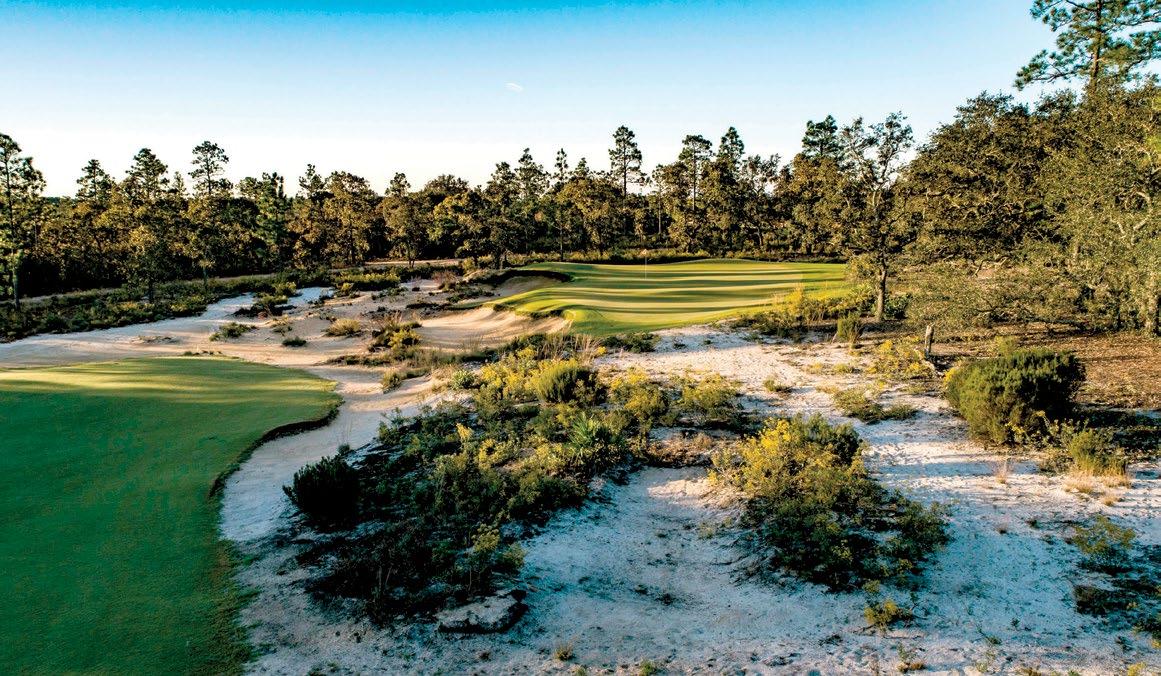
the-box idea to create a course devoid of par and built specifically for match play—he had two things working in his favor. First, the resort was home to four other traditional layouts, meaning the prospect of an atypical course that promised a unique golf experience had some allure. Second, the resort’s then director of golf, Jane Broderick, believed Staples’s idea was long overdue. In fact, according to Staples, she initially responded by saying, “I cannot wait for the backlash from the traditional Florida golfer when they show up on the first tee and we point them to the nearest pay phone and tell them to call someone who cares.”
Golf Travel - Match Play
“Every time golfers play the Match it can be a different golf course.” —Jane Broderick
But in Broderick’s estimation, the unorthodox course had the potential to be more than a one-finger salute to stodgy golfing expectations. It had the ability to shapeshift. “Every time golfers play the Match,” Broderick excitedly said just after the layout opened for play, “it can be a different golf course.”
The Match opened in late 2021, and another notable Florida resort has since opened a match-play course of its own (more on this later). But the concept of American layouts designed to be predominantly— or exclusively—match-play courses can be traced back to 1990, when Mike Keiser worked with Dick Nugent on a nine-hole course in southwest Michigan, slightly more than an hour’s drive outside of Chicago.
The private loop at the Dunes Club is rated with an official par designation, but members and guests most often encounter the course devoid of any tee markers. Much like the encouraged format of play at PGA National, here at Keiser’s first golf course, it’s all about match play and teeing it up wherever the winner of the last hole desires. “You could play all nine holes however many times and never have the same shot twice,” says golf correspondent Alexandra O’Laughlin. “It was such a unique way of playing golf and just a really enjoyable experience.”
The concept of a course built specifically for match play didn’t make headlines until Ohoopee Match Club opened in Georgia in 2018. Designed by Gil Hanse, the course was originally the vision of the club’s founder, Michael Walrath. The New York businessman wanted to create a venue that embraced the camaraderie that goes along with the style of matches that he often played with his buddies.
ISSUE 60—KINGDOM— 107
Ohoopee Match Club’s 17th hole.


Nestled in the heart of the Lowcountry, Palmetto Blu ’s 20,000 acres, 32 miles of coastline, and over 10,000 yards of captivating fairways are yours to explore. Immerse yourself in world-class golf crafted by renowned designers—Jack Nicklaus, King-Collins, and Coore & Crenshaw—and indulge in the ultimate golfing lifestyle amidst a breathtaking coastal setting. Beyond the greens, discover an extraordinary residential community that redefines luxury. From exquisite homes and estates to top-tier private club amenities and impeccable service, Palmetto Blu embodies the essence of Lowcountry living.
Discover Ownership
843.891.1293 | palmettobluff.com/kingdom
Obtain the Property Report required by federal law and read it before signing anything. No federal agency has judged the merits or value, if any, of this property. This does not constitute an offer to sell or a solicitation of any offer to buy where prohibited by law. The complete offering terms are in an offering plan available from sponsor. File no. H-110005
MASTERPIECES MADE CLOSE TO home


“We weren’t worried about people thinking that we created a terrible golf hole because they just made a seven.”
—Gil Hanse
“It was liberating to know that it was only going to be match play,” Hanse says of the Ohoopee project. While novel, those marching orders didn’t require Hanse and his partner, Jim Wagner, to reinvent the wheel. In fact, Hanse acknowledges that they typically design with match play in mind no matter what course they’re creating. “We love to build golf courses that end with holes where you can score well, because that’s where matches get swung,” he explains. “We want interesting, exciting stuff coming down the end, where positive swings in a round of golf can decide a match versus hanging on for dear life.”
Golf Travel - Match Play
Hanse says, “because we weren’t worried about people thinking that we created a terrible golf hole because they just made a seven.”
At Ohoopee, Hanse and Wagner could lean into that. “We could take bigger risks and bigger rewards because a lot of the decision-making for how you were going to approach those holes is predicated on how your match is going,” Hanse says. “There was never the fear of [a golfer thinking], ‘I don’t want to take this [shot] on because I might have to write down an eight on my scorecard and my score will be ruined.’ Instead, it was the mindset of, ‘I’m two down and I’ve got to make something happen, so I’m gonna take that risk.’ ”
Therein lies the beauty of match-play architecture. It can be bigger and bolder than what you might see on a traditional course. It can offer more substantial risks and more lucrative rewards. “We took more chances,”
In central Florida, Streamsong Resort just opened the Chain, a “short” course designed by Bill Coore and Ben Crenshaw. Short is a relative term; some holes peak at only 109 yards, while others can stretch to almost 300. In total, the track meanders across 36 acres and offers almost 3,000 yards of golf. Like the Match course at PGA National, the Chain features long, ribbon teeing areas, and all of its 19 holes are devoid of par. But unlike PGA National’s course, the Chain wasn’t conceived with match play in mind.
After Coore and Crenshaw finalized the course’s routing, the team at KemperSports, which owns and operates the resort, began to reassess what the Chain’s role should be at Streamsong. “We kept asking the question, ‘What do we want this to be?’ ” says Keith Hanley, KemperSports’ senior vice president of operations. “Knowing that this could be the second or third round of the day for a number of our guests, we wanted them to go out and have fun—grab a couple of beers, take their shoes off, but have a real golf experience. And we realized that match play would be super fun; it can be played a little bit faster, and you don’t have to count every score.”
ISSUE 60—KINGDOM— 109
The Dunes Club (left; photo: Jon Cavalier) and the Chain at Streamsong Resort (right; photo: Bill Hornstein).
It was a subtle shift that Coore and Crenshaw immediately embraced. “If you know that people are going out to play and are not trying to post a numerical score relative to par, then the holes can oftentimes be more dramatic; they can be more unique in their presentation,” Coore explains. “The designs can be more on the edge in terms of playability and forgiveness because it’s all about playing one hole at a time. It’s not about a collective score.”
In that way, the ideology for creating a match-play course is similar to the approach that Coore and Crenshaw take when creating short courses. “We can do more interesting things, particularly on the greens and around the greens,” Coore says, explaining that because players are hitting shorter shots with higherlofted clubs, aggressive contouring, mounding and steeply graded run-off areas are all in play. “When you take strength and length out of the equation, golf becomes much more fun for a vastly expanded group of players.”
Although Coore loves the concept of match-play courses, he questions if they’ll ever rise to prominence within the game. It’s a stance that Hanse also shares. “At a public facility where you want people to show up and play, I’d like to think that it could work, but golf’s a funny thing,” Hanse says. “Some people just get so fixated on card and pencil, that even while they’re playing a match they kind of want both worlds.”

“The designs can be more on the edge... because it’s all about playing one hole at a time.” —Bill Coore
Golf Travel - Match Play
Seventy-six miles north of Streamsong, at Cabot Citrus Farms, Ben Cowan-Dewar is attempting to offer golfers exactly that. Only a few yards shy of 3,000, the Squeeze is a nine-hole course that Cowan-Dewar envisions being an add-on for members and guests who are itching for more golf during their day but perhaps aren’t up for another full round. Conceived by Mike Nuzzo, an architect who early in his career created Wolf Point—a private course in Texas built for a single owner for his matches with friends and guests—the Squeeze features five par-4s that are 350 yards or less and is outfitted with flowing tee areas that support the “winner chooses” method of match play.
That said, the Squeeze is rated and does sport a formal par, even though Cowan-Dewar acknowledges that he fully supports “anything that encourages match play.” In Nuzzo’s opinion, golf would be exponentially
better if more courses not only encouraged match play but were designed with that in mind. “I wish every golf course was more like a match-play course,” he says. “It’s so much more interesting and with more varied ways of play—just whoever gets in first wins.”
Despite his enthusiasm for match play, CowanDewar pushes back on the idea of creating courses with only that purpose in mind. “Because our mission is having golf be fun and informal, you’ll continue to see us encourage match play,” he says. “But we’re not going to tell people how to experience the course if they care deeply about turning in their score.
“We want people to have fun—that’s number one,” he continues. “And we want to build the best collection of golf holes that we can—that allows for an amazing experience. I love giving people flexibility, and however you choose your own adventure, we’re open to that.”
110 —KINGDOM—ISSUE 60
The Squeeze at Cabot Citrus Farms (photo: Jeff Marsh).


A MAN & A HALF



112—KINGDOM—ISSUE 60



It was Sean Connery—Scotsman, golfer, 007—who once said: “A man in a kilt is a man and a half.” The plaided pedigree of this Scottish sartorial fixture will be on full display this spring at a one-of-a-kind golf tournament hosted by a singular Highlands hotel. Robin Barwick reports.
The kilt is a garment of true versatility. Traditionally woven from the wool sheared from a sheep that has been reared in the Scottish Highlands, a tartan kilt is as appropriate for a wedding, funeral or graduation as it is for tossing the caber, putting (throwing) a stone or—dare we suggest—playing a round of golf.
Golf Travel - Kilted Golf
A breezy option perhaps, but playing golf in a kilt does bring together two of Scotland’s age-old icons. And if you throw in a nip of Scotch on the first tee, for courage, well, then you have the full triumvirate.
Last summer, the Fife Arms in Aberdeenshire— once a 19th-century hunting lodge, now a hotel of extraordinary artistry and elan—launched the Kilted Open, an event that blends all of these fine Scottish traditions into a one-of-a-kind golf tournament.
The Fife Arms is the centerpiece of the remote Highlands village of Braemar, which is best known in Britain for two reasons: firstly, as one of the most likely habitations to welcome a white Christmas (the winters here are cold, even by Scottish standards); and secondly, as home to the Braemar Gathering for more than 900 years. Gatherings—or Highland Games—are held at a variety of Highlands locations, with Braemar’s being particularly renowned, as it has been attended by members of the royal family every year since 1848.
Now, with the Kilted Open, Braemar is aiming to make its mark in a novel new way. A Texas scramble played by teams of four over 18 holes, with a shotgun start, the invitational event will unfold at Braemar Golf Club, May 17–19, as part of a two-night
ISSUE 60—KINGDOM— 113 TRAVEL The Highlands
The Fife Arms, Braemar

A TASTE FOR Tartan
A tartan is more than fabric—it is fabric woven with family history and pride, and it gets emotional.
John McLeish, chair of the Scottish Tartans Authority, tells Kingdom: “Tartan is a story of feelings. In a kilt, tartan is the design applied to woven wool, but it is the feelings that make it special. They may be based on myths or facts, but they are real feelings all the same, and people wear their tartan with pride. I am charged with emotion when I walk onto the games ground for the Braemar Gathering, thinking of our forefathers and carrying on this tradition.”
It is a misconception that only Scots are entitled to have their own tartan. Anyone can create one, although as weaving a tartan is complex, expert guidance is highly recommended. Every new tartan needs to be registered with the Scottish Register of Tartans, which conducts searches to confirm that each tartan is unique.
hotel package. Golfers can enter their own four-ball or form part of a team with other guests, and the hotel’s hospitality will extend to providing on-course refreshments and a postround barbecue and prize ceremony. The two-day event also features a nine-hole excursion to the Balmoral Estate, the Scottish retreat of the Royal family, just 10 miles up the road.
Golf Travel - Kilted Golf
“The kilt is my refuge, my home.”
—Sean Connery
The wearing of a kilt is not compulsory at the Kilted Open, although encouraged, and the hotel can arrange rentals. The tournament’s venue, Braemar GC, occupies a serene tract of Glen Clunie, with the river basin golf course shaped on one side by the bends of Clunie Water, a tributary of the River Dee and a good stretch for fly-fishing brown trout. The valley is hemmed by vast hillsides covered in pine, birch, purple heather and juniper. During rutting season in October, the bellowing of stags from the most prominent hill, Morrone, can be heard daily, at dawn and dusk in particular, as the animals descend from the high ground to patrol the lower slopes. If you are lucky, a golden eagle might soar overhead.
Visit tartanregister.gov.uk/links for a list of tartan designers and weavers. The list includes Lochcarron of Scotland, which produced a new King Charles III tartan last year, and which His Majesty The King wore to the Braemar Gathering in September.
They keep things simple at Braemar GC, ensuring that this course—which expanded from nine holes to its current 18 in 1911—keeps in step with its wondrous surroundings. With a membership of 100, Braemar’s modest clubhouse is only open from April until October, and during the remaining months of reduced daylight, golfers are expected to pay their greens fee into an honesty box by the first tee.
The course was drawn up by Balgownie professional Bob Mearns, who had also created the idyllic nine-hole course at the 50,000-acre Balmoral Estate, a course originally reserved for the royals and staff. The development of the Braemar course was largely funded by William Pirrie (the Right Honorable Viscount Pirrie—or Lord Pirrie—to be official), the club’s captain of 1910. Pirrie was longstanding chairman of the world’s largest shipbuilder of the time, Harland
114 —KINGDOM—ISSUE 60
Teeing off in the inaugural Kilted Open in 2023. Opposite: The historic Fife Arms; one of the hotel’s luxe Victoriana suites; the property’s seductive Bertie’s whisky bar.



and Wolff in Belfast, which built the Titanic. (Pirrie’s nephew, Thomas Andrews, designed the Titanic and perished on its ill-fated maiden voyage in 1912. Pirrie was among those who claimed the ship was unsinkable and happened to miss the tragic voyage due to illness.)
Golf Travel - Kilted Golf
Like many before and since, Pirrie was captivated by the natural splendor of this Highlands region, which is part of Cairngorms National Park. Queen Victoria was, too. She and Prince Albert bought the Balmoral Estate in 1852 and built Balmoral Castle. No sooner had construction of the castle been completed in 1856 than the Fife Arms hotel opened. The name can be confusing, as Braemar and the hotel lie 60 miles to the north of the border of the Kingdom of Fife, but the hotel was built as a hunting lodge by the Duke of Fife, who had married into the royal family. The Fife Arms was bought by Swiss art collectors and gallery owners, Iwan and Manuela Wirth, in 2014, and brought into their Artfarm hospitality group. After five years of redevelopment, the hotel reopened in 2019. The bold ambition was to rekindle the hotel’s Victorian splendor—an age when the Fife Arms would welcome Queen Victoria and host lavish balls for the royal family—while introducing impeccable 21st-century luxury. The result is an unqualified triumph.
Each of the 46 guest rooms and suites is bursting with a distinct personality, telling its own story with period antiques and original works of art. The same attention has been devoted to the public spaces, from the sophisticated Clunie Dining Room to the Drawing Room, where a typically peculiar (and original) portrait by Pablo Picasso puzzles guests over afternoon tea. Bertie’s whisky bar offers an interior of intoxicating burgundy, offset by mirror-backed shelves stocked with 400 different whiskies, while the hotel’s Flying Stag pub—which boasts an array of Highlands artifacts—offers traditional and seasonal fare of the highest caliber.
Come May, the artistry of the Fife Arms will combine seamlessly—no doubt—with the skills of kilted golfers. The Kilted Open highlights the hotel’s golf program, with other options including guided excursions to other golf courses in the region, such as Blairgowrie, Open venue Carnoustie and the great links of the Aberdeenshire coast, including Royal Aberdeen and Murcar.
As the Fife Arms embraces golf in its own, tartan-clad way, so golfers are invited to embrace the Fife Arms. It’s a good swap, as there is probably no better place to begin and end a day of Scottish pursuits.
ISSUE 60—KINGDOM— 115

HELI FOR ALL
At a pair of chalets in the French Alps, you don’t have to be an extreme athlete to enjoy the ultimate skiing experience.
By Bruce Wallin
Photography by Yann Allègre, courtesy of Eleven

First came the beacon: a red canvas strap looped around my right shoulder, holding in place the homing device by which rescuers could locate me in case of an avalanche. Next, the backpack: a parachute-like contraption outfitted with a ripcord to be pulled as a preemptive strike, triggering a massive balloon designed to “float” me to the snow’s surface. (I was told, in no uncertain terms, that the cord must not be pulled inside the helicopter.)
Wellness - Heli-wellness
Ominous as its various implications were, the gearing-up process for my day of heli-skiing was more reassuring than it was intimidating. Until it came time for the harness.
“What’s this for?” I asked while my guide, Jean-Noël Gaidet, cinched the harness’s straps around my legs and waist.
“In case you fall into a crevasse,” he replied, expressionless.
Crevasses, avalanches, high-altitude helicopter flights—there are plenty of good reasons not to go heli-skiing. Any serious risks, however, are greatly mitigated by established outfitters like Eleven, the adventure company that was leading my excursion along the FrenchItalian border. A more pressing, realistic concern for many would-be participants is heli-skiing’s perceived difficulty. The fear of being stuck in a situation you can’t get out of—peering over a precipice at the top of a blustery peak, beyond the reach of chairlifts and ski patrol—is enough to keep many skiers confined to resort slopes.
ISSUE 60—KINGDOM— 117 TRAVEL Adventure
Such a fear might be justified in destinations like Alaska, British Columbia and Kamchatka. In the French-Italian Alps, however, a far more accessible experience awaits. Rather than hard-core, weeklong retreats to remote lodges, heli-skiing excursions in these parts are offered as day trips, one-off additions to otherwise normal winter holidays. The excursions cater to everyone from intermediates to experts, and typically conclude with a fabulous French or Italian meal, depending on which way you turn at the top.
ELEVATION: ELEVEN
I was staying with a group of skiers of varying abilities at Chalet Hibou, one of Eleven’s growing collection of boutique adventure properties worldwide. Founded by former Blackstone executive Chad Pike, Eleven pairs exhilarating outdoor activities with impeccable amenities at its lodges in Colorado, Chilean Patagonia, Iceland, New
Zealand and beyond. Heli-skiing and fly fishing are the main attractions at several of the properties, many of which operate on an exclusive-use basis.
Hibou and its across-the-street neighbor, Chalet Pelerin, have 12 bedrooms between them and can be rented individually or as a pair. The chalets sit on a high slope in the Tarentaise Valley village of Le Miroir, at the top of a road so narrow and switchbacked that it requires a four-point turn to navigate at least one corner.
Inside the residences, wooden staircases connect the bedrooms and a collection of inspired spaces—a hidden bar, a music loft, a sitting room where a crackling fire accompanies après-ski cocktails. The room, as so many others in the chalets, opens to a balcony with fairy-tale views of pitched rooftops descending to the river valley below, then rising again toward towering peaks on the opposite slope.
Meals at the chalets embrace this magnificent milieu, with private chef–
made breakfasts and dinners featuring local eggs, cheeses, lamb, duck—hearty French fuel for adventure-filled days. Those adventures might mean mountain biking, hiking, river rafting and canyoneering in the warmer months. My visit, in mid-January, came at the height of winter, prime season for snowshoeing, ice climbing, dogsledding and, of course, skiing.
Eleven’s chalets are within a short drive of several ski areas, including Sainte Foy and La Rosière. Our group spent the first two days at Val d’Isère and Tignes, sibling resorts spread over a massive swath of peaks and valleys near Mont Blanc. We started with easy groomed runs, but on day two, at Tignes, our guides graduated us to more challenging, off-piste terrain.
The ungroomed slopes offered the chance to make fresh tracks in day-old powder, as well as to become acquainted with our safety gear. Unbeknownst to us, they also served as a test—to see what we could handle in the day ahead.
Wellness - Heli-wellness


118 —KINGDOM—ISSUE 60
Eleven’s Chalet Hibou, in the French Alpine village of Le Miroir, offers an elegant base for heli-skiing and other exhilarating adventures.


ALPINE PRIMED
Wellness - Heli-wellness
THEY HAVE OUTFITTED YOU FOR SAFETY AND PREPARED YOU FOR YOUR PEAK PERFORMANCE. THE REST IS UP TO YOU.
Of the many differences between skiing in, say, the Rockies and the Alps—leisurely lunches of Dover sole and Sancerre, among them—most boil down to tradition. The Alpine cultures of France and nearby nations have been living in these parts for thousands of years, and the mountains are ingrained in who they are and what they do. The Alps are them, and they are the Alps.
Within that framework, the concept of heli-skiing becomes somewhat less intimidating. Should you really squeeze into a single-engine aircraft and fly through 14,000-foot peaks at breakneck speeds, only to then ski down those same crevasse-filled slopes? When you’re being guided by someone like Gaidet—a lifelong mountaineer who grew up in Le Miroir and now lives a couple doors down from Eleven’s chalets—your answer becomes yes.
Gaidet and his fellow guides err on the side of caution when it comes to heli-skiing routes. When conditions are good—as they were during our trip—the range of options is plentiful, from gently rolling slopes to high-pitch faces. As much as they can, the guides will pair you with similarly skilled skiers (four per helicopter, not including the guide) and select your drop-off locations and routes accordingly.
That doesn’t mean they’ll hold your hand on the way down. French mountain guides are, well, French. They might listen to you complain about your boots or how you’re too tired for another run—and then promptly ignore you and soldier on, not paying much attention to whether you’re behind them or not. The idea is that they have already gauged your abilities, outfitted you for safety and prepared you for your peak performance. The rest is up to you.
ISSUE 60—KINGDOM— 119














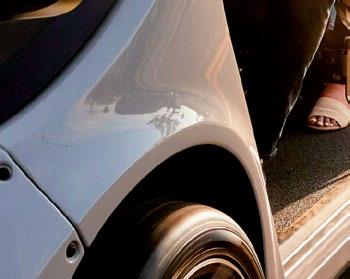







GEM


Wellness - Heli-wellness
“I’M SUDDENLY NERVOUS,” SAID MY GERMAN SKIING PARTNER AS THE HELICOPTER CAME INTO VIEW.
BLANC CANVAS
The night before taking flight, our group donned headlamps and hiked through the snow to Le Crot Alpage, a century-old sheepherder’s hut where Eleven hosts backcountry dinners. A feast that started with fondue by the fire—and ended with shots of génépi, the local digestif made from a highaltitude flower—would have been a worthy last meal.
Any cobwebs the next morning quickly dissipated during the gearing-up process, when the need to stay focused on our day of skiing became imminently clear. After suiting up, we drove to the base of La Rosière, where we took a series of lifts and groomed trails to the top. There, we turned and skied down to Espace San Bernardo, the connected resort on the Italian side of the border. (Heli-skiing is not permitted in France, but
the fluid border with Italy makes it easy to access flight operators on the other side.)
We gathered at San Bernardo’s mid-mountain base and split into two groups of five. After another equipment check, we were prepared for the helicopter’s arrival: Drop to a knee behind the guide. Wear your gloves and hat tightly. (The powerful blade gusts knocked one of my skiing partners from a kneeling position to flat on her back in the snow at one point.) Board the helicopter one by one, in rapid succession, when the guide says go.
We could hear the helicopter before we could see it. Somewhere in the Alpine expanse, a chopper was headed our way, growing louder by the second. “I’m suddenly nervous,” said my German skiing partner—an expert skier—as the helicopter came into view.
ISSUE 60—KINGDOM— 121


GO ONE WAY DOWN THE MOUNTAIN INTO FRANCE, THE OTHER WAY INTO ITALY.
Wellness - Heli-wellness

Those nerves turned to adrenaline when we took off and sped low toward a distant ridge, with Mont Blanc looming to our left. San Bernardo’s chairlifts faded from view as we rose through a valley and up to our first drop-off point—a flat, snowy meadow at the top of the world.
Within seconds of being dropped, we were alone, the sun shining overhead and powder stretching in every direction below. Our guide started us down a gentle, wide-open slope, then led us through a shadowed valley, over a small ridge and into a sunny bowl. We were above the tree line and floating on air. It was, quite simply, the best run of my life.
And then we did another.
Heli-skiing days in Italy can involve as many “laps” as you have time for, are willing to pay for and have the endurance to withstand. Indeed, the challenge of our route was more in the required stamina— skiing in knee-deep powder with very few breaks for nearly an hour straight—than it was in the difficulty of the runs (most of which would be blue-squared at an American ski resort).
At the top of our second drop, we had a choice: go one way down the mountain into France—where we could ski all the way to Chalet Hibou’s back door—or the other way into Italy. Given that our guides had booked a reservation
at a popular inn near San Bernardo, our choice was clear.
After another epic run down the mountain, we regrouped for a long, lazy lunch of prosciutto, house-made pasta and Italian wine. But our day wasn’t over yet: At the end of the meal, we rushed back to San Bernardo, skiing with abandon toward France before the connecting lifts closed.
Arriving at the base of La Rosière, we peeled off our boots, beacons, backpacks and harnesses in the resort parking lot. In less than an hour, we were settled back at the chalet, safe and sound in the sitting room—and still buzzing from the high of heli-skiing.
122 —KINGDOM—ISSUE 60
Guide Jean-Noël Gaidet prepping Chalet Hibou guests for a powder-filled day.








e Right Choice Starts Here
For lovers of golf, Berkeley Hall o ers two Tom Fazio-designed golf courses, a celebrated 33-acre golf practice and learning facility, and a community of golfers always ready to welcome new players.


Resting on the banks of the Okatie River in South Carolina’s Lowcountry, we’re an intentionally small community with the grandeur and amenities of a luxury resort. e right size. e right location. e right community for you and your family.
We invite you to choose from our exceptional inventory of new homes, or select a homesite on which to envision the custom home of your dreams, and join our family of Members at Berkeley Hall. for homesite

· BERKELEYHALLCLUB.COM · BLUFFTON, SC
843-815-8423
THE EVERYONE

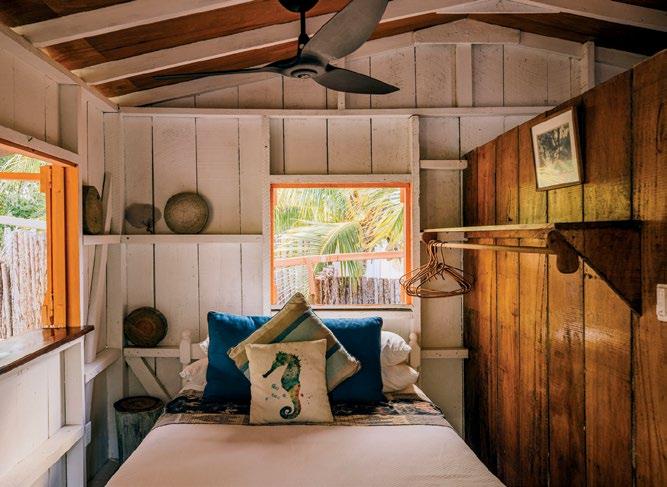
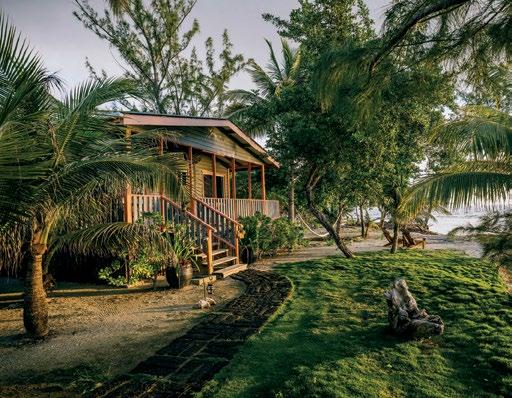
124 —KINGDOM—ISSUE 60

ESCAPE
With multigenerational trips on the rise, we present 7 epic adventures sure to thrill family members of all ages.
By Gina DeCaprio Vercesi
The recipe for a perfect multigenerational adventure is fairly straightforward: Take a naturally beautiful destination and combine it with commodious accommodations, flexible dining options and a host of crowd-pleasing pursuits that will entice everyone from toddlers and teens to parents and grandparents. Following are seven ideas for that big family getaway guaranteed to delight even the most diverse and discerning bunch.
Golf Travel - Multi Gen
and melodious blackbirds on an early morning birdwatching tour, traverse the rainforest on horseback or simply head out from your cabana for some cliff-jumping and swimming in the river. Off-site adventures—including visits to the ancient archaeological wonder of Caracol—delve into Belize’s rich Maya culture.
RAINFOREST TO SEA in Belize
When director Francis Ford Coppola discovered the then-abandoned Blancaneaux Lodge in Belize’s Mountain Pine Ridge Forest Reserve in 1981, he knew immediately that he’d found the perfect location for a remote family retreat. In the ensuing years, the Coppolas transformed the lodge into a luxurious eco-resort that, appropriately, is ideal for family retreats. Its 20 mountainside cabanas and villas are set amidst a lush landscape of waterfalls and swimming holes, tropical gardens and forested pathways. Search for toucans, scarlet macaws
A three-hour drive south along Belize’s Hummingbird Highway brings you to the vibrant fishing village of Placencia and Turtle Inn, Coppola’s Balinese-inspired beach hideaway. Families stay in roomy, thatch-roofed cottages scattered throughout an Eden-like property steps from the Caribbean Sea. For the full castaway experience, head to Coppola’s nearby Coral Caye, an all-inclusive privateisland escape that accommodates up to 10 guests. Both properties sit within the Belize Barrier Reef, the second-largest reef system in the world, which means days can be filled with snorkeling or scuba diving adventures, saltwater fly fishing and cruising the nearby Placencia Lagoon in search of gentle West Indian manatees. thefamilycoppolahideaways.com
ISSUE 60—KINGDOM— 125 TRAVEL Family Getaways
The Family Coppola Hideaways’ Coral Caye in Belize.

INTO THE WILD in Alaska
Golf Travel - Multi Gen
Family adventures in Alaska often mean cruise ships shared with hundreds of fellow passengers. A very different experience awaits at Within the Wild, a pioneering travel company led by Kirsten and Carl Dixon. Tucked into a secluded cove on Katchemak Bay—one of the world’s richest ocean ecosystems—and surrounded by snowcapped mountains and towering Sitka spruce, Within the Wild’s exclusive Tutka Bay Lodge offers a luxurious base for adventures throughout the Alaskan wilderness. Settle into one of six handcrafted timber cabins, each with cozy woodstoves and sweeping water views, before setting out on one of the lodge’s many guided pursuits, from hiking through old-growth forests and spotting Alaska brown bears to sportfishing for halibut and salmon. Children of all ages are welcome at the lodge (although it’s best for ages 5 and up), and activities can be tailored appropriately. Food is a special part of the experience for just about every guest, as Kirsten trained at Le Cordon Bleu in Paris and now runs a cooking school at the lodge. Culinary enthusiasts will enjoy going on a foraging expedition with one of Tutka Bay’s chefs and returning to transform wild ingredients into an Alaskan feast. withinthewild.com
Hike through old-growth forests, spot Alaska brown bears and fish for halibut and salmon.
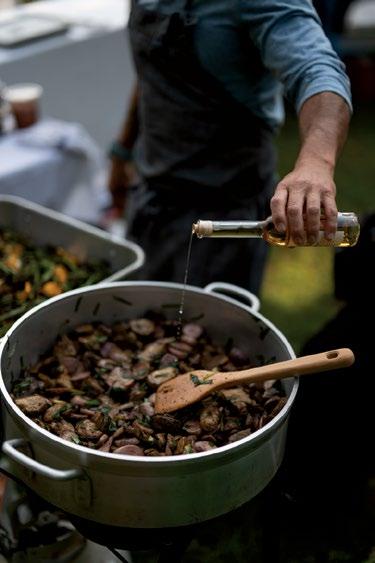
126 —KINGDOM—ISSUE 60

LA DOLCE VITA in Puglia
Golf Travel - Multi Gen

Tuscany is often considered the quintessential destination for villa rentals in Italy, but a distinctly southern Italian experience awaits in the province of Puglia. Here, in the heel of Italy’s boot, you’ll find olive trees dating back to the Roman days, some of the country’s most beautiful beaches and sleepy towns and villages where the rich culinary legacy includes homemade orecchiette, creamy burrata cheese and little pockets of dough stuffed with fresh tomato and mozzarella called panzerotti. Puglia is a particular specialty of The Thinking Traveller, a villa rental service that has exclusive access to some of the most fabulous properties in Europe. The company works with specialists in the area to provide insider experiences like a cheesemaking class near the fairy-tale village of Alberobello, kayaking in the gin-clear waters of the Adriatic or an in-villa workshop in pizzica, a traditional dance fabled to be the cure for a tarantula bite. For a direct path to the sea, consider L’Argentiera, which sleeps 18 people in nine bedrooms and is located a short stroll from the charming village of Castro Marina in southern Puglia. Smaller groups should consider Trullo Rosmarino, a five-bedroom retreat set on three acres an easy walk from Martina Franca. thethinkingtraveller.com
SADDLE UP in Arizona
Since 1965, the True family has been welcoming guests to their historic Dude Ranch in Tucson in classic Old Western style. Set on 3,000 acres in the rugged Sonoran Desert, White Stallion Ranch is home to an enthusiastic staff of expert wranglers who oversee one of the largest private herds of horses in the state. Children as young as five are welcome to get out on the property’s seemingly endless maze of trails, where you can spend your days loping amid towering saguaro cacti and fragrant creosote bushes. (Littler ones can saddle up for lead line rides around the corral.) For adventures of the non-equine variety, you can try your hand at archery or target shooting, explore the property on a fat-tire bike or head out for a hike in nearby Saguaro National Park. Evenings call for desert stargazing, country line dancing and cowboy songs by the fire. The ranch offers a wide array of family-friendly accommodations, including the Hacienda, an airy, Spanish-style home that sleeps 10. whitestallion.com
ISSUE 60—KINGDOM— 127
Puglia’s Trullo Rosmarino villa (above); trail ride at White Stallion Ranch.




ON SAFARI in South Africa
Golf Travel - Multi Gen
Sprawling across 284,000 acres in the Northern Cape, Tswalu Kalahari is the largest privately owned reserve in South Africa. Along the dune roads that wind through the reserve’s variety of habitats, expect to spot giraffe, ostriches, oryx and zebra, as well as more elusive wildlife like black-maned lion, desert black rhino, brown hyena and African wild dogs. Conservation has been at the heart of Tswalu’s mission from the beginning, and guests have the opportunity to interact with on-site researchers throughout their stay, from biologists monitoring meerkats to herpetologists studying puff adders.

Tswalu accommodates only 40 guests at a time on the vast reserve, and all safari guides and vehicles are private to your party—a huge benefit when traveling with kids. Choose to stay in one of three distinct camps, each set away from the others and offering a remarkable sense of seclusion. For larger groups, Tarkuni Homestead can hold as many as 10 people in five luxurious suites and includes its own private chef. Parents traveling with older children can stay at the new Loapi Tented Camp, six ultra-private safari homes set in the foothills of the Korannaberg Mountains. tswalu.com
ISSUE 60—KINGDOM— 129
Tswalu Kalahari’s exclusiveuse Tarkuni Homestead.

ISLAND HOPPING in the B.V.I.
Home to steady trade winds, calm seas and protected anchorages aplenty, the British Virgin Islands have been a cherished destination for sailors since the 1960s. The oldest, most respected charter company for exploring the archipelago’s 50 odd islands is The Moorings, which set up shop on Tortola in 1969. The company now owns a fleet of more than 300 vessels that runs the gamut from classic monohulls to sleek, spacious catamarans, the latter of which can be booked fully crewed and offer plenty of room for families to spread out in style.
Watch the kids bomb off the side of the boat while the blender whirs in the background.
Golf Travel - Multi Gen

HISTORY AND CULTURE on the Emerald Isle
Chart a course that includes searching for sea turtles in Manchioneel Bay off Cooper Island, hiking through massive granite boulders at Virgin Gorda’s Baths National Park, strolling along the pink sands of Cow Wreck Beach on Anegada and whiling away the hours sipping Painkillers and playing tiki toss at the famed Soggy Dollar Bar on Jost Van Dyke. Regardless of where you drop anchor, you’ll be surrounded by the ultramarine waters of the Caribbean. It doesn’t get much better than watching the kids bomb off the side of the boat while the blender whirs in the background. moorings.com
The heritage and beauty of Ireland make the country an unparalleled destination for a multigenerational vacation. Smithsonian Journeys can curate tailor-made trips around just about any area of interest. Tour Dublin by bicycle and explore the tumultuous story of Ireland’s independence at the Kilmainham Gaol Museum. Sip a pint at the Guinness storehouse. Take a ride in a traditional Irish carriage through the ancient oak forests of Killarney National Park. Sleep in a castle dating back to the 16th century and delve into the ancient art of falconry with the resident birds of prey. Drink in dramatic views during a hike on the Cliffs of Moher Coastal Walk. Watch sheepdogs hard at work during a herding demonstration at a local farm. Each trip draws on the Smithsonian Institute’s deep commitment to history and culture, while expert guides ensure the experience is interactive and engaging for all. smithsonianjourneys.org
130 —KINGDOM—ISSUE 60
The British Virgin Islands (left) and Ireland’s Kinsale Coast.




Without doubt Arnold Palmer’s West Barrow, Ardfert, Tralee, Co. Kerry +353 (0) 66 713 6379 www.traleegolfclub.com facebook.com/traleegolfclub Tra lee GOLF LINKS
Europe
finest links course in
MAJOR MIXOLOGY
Drinks - Major Mixology

In majors mood, we headed to the Seal Bar at the famed Marine Troon hotel, which handily looks over the first and 18th holes of the Old Course at Royal Troon—venue for The Open in July. With expert guidance from bar manager Curtis McConnell, we uncovered a quartet of whisky cocktails and assigned them each a major championship. Here, we raise a toast to green jackets, grand slams and champions past, present and future with Kingdom’s Major Cocktails for 2024.
Words: Robin Barwick
Photography: Matthew Halnan

132 —KINGDOM—ISSUE 60 DRINKS Major Cocktails
THE MASTERS
TAM O’SHANDY
Tam O’Shanter was a drunken farmer in one of Robert Burns’s most famous poems. Burns hailed from just outside Ayr—not 10 miles south of Troon— which was also home to the fictional O’Shanter. The entirely fitting Tam O’Shandy was a Burns Night special enjoyed by guests at the Marine Troon, and this refreshing cocktail would taste great on a sunny April afternoon in Georgia.
Drinks - Major Mixology
Ingredients
• 1 ounce Aberfeldy 12 Year Old Single Malt
• ½ ounce Grand Marnier
• 1 ounce freshly squeezed lemon juice
• ½ ounce sugar syrup
• Tennent’s lager
Method
Mix first four ingredients over ice in a highball glass. Top up with Tennent’s lager. Garnish with dehydrated lemon.

ISSUE 60—KINGDOM— 133


Drinks - Major Mixology
With the PGA Championship returning to Valhalla, outside Louisville, Kentucky, a bourbon-based cocktail is compulsory.
Ingredients
• 2 ounces Angel’s Envy bourbon
• 2 teaspoons Punt e Mes vermouth
• 2 teaspoons maple syrup
• 2 dashes Angostura bitters
• 2 dashes orange bitters
TROON OLDFASHIONED
Method
Combine ingredients over ice in a mixing glass.
Strain onto ice in a lowball crystal rocks glass.
Garnish with flamed orange peel.
134 —KINGDOM—ISSUE 60
PGA CHAMPIONSHIP
ROB ROY

Drinks - Major Mixology

Dewar’s is commemorating the 124th U.S. Open— held at the iconic Pinehurst No. 2—with its 2024
19 Year Old “The Champions Edition” whisky, which adds a smooth touch to this classic cocktail.
Ingredients
• 2 ounces Dewar’s 19 Year Old “The Champions Edition” 2024
• 1 ounce Martini Riserva Speciale sweet vermouth
• 1 dash Angostura bitters
Method
Combine ingredients over lots of ice in a mixing glass.
Stir to dilute to taste.
Strain into a Nick & Nora glass. Garnish with a twist of lemon peel.
ISSUE 60—KINGDOM— 135
U.S. OPEN
ESPRESSO

A sophisticated closer for the final major of the season, with Brazilian coffee flavors complementing the dark chocolate notes of Loch Lomond whisky, from nearby Glasgow.
MARTINI
Drinks - Major Mixology
Ingredients
• 1 ounce Loch Lomond Open Special Edition Single Malt
• 1 ounce Mr. Black coffee liqueur
• 2 ounces espresso (preferably Brazilian, single-origin, 100 percent arabica coffee)
• ½ ounce sugar syrup
• 2 drops saline solution
Method
Shake ingredients over ice. Strain into a classic coupe. Finish with chocolate dusting. Garnish with coffee beans.
136 —KINGDOM—ISSUE 60
THE OPEN
WHISKY

ISSUE 60—KINGDOM— 137

Drinks 2 - Cask Hunters

138 —KINGDOM—ISSUE 60
Independent
Above: A selection of Lost Lantern’s Single Cask Series whiskies.
Right: Lost Lantern’s first American Vatted Malt.
Spirit
As the first independent bottler dedicated to American whiskey on a national scale, Lost Lantern is exploring a new way to understand and appreciate the diversity of the country’s craft distillations.
By Shaun Tolson
Lost Lantern is the first to take a national approach to the trade. Set within the former premises of a cidery in northwest Vermont, the independent bottling operation is modest in appearance. That facade, however, belies the company’s scope and the quality of the whiskey that Ganley-Roper and Polonski are spearheading and bottling.
Britain’s influence on American culture is undeniable, but there are certain practices that never made their way across the pond. We don’t shower our French fries with generous dashes of malt vinegar, for example, and it would take a dedicated search effort to uncover an American bar that offers cask lines of beer. When it comes to American whiskey, the country is teeming with distilleries, but it’s almost devoid of the type of independent bottlers that are popular across the UK.
Drinks 2 - Cask Hunters
Nora Ganley-Roper and Adam Polonski, the founders of Lost Lantern, are aiming to change that. Well, sort of.
Ganley-Roper was a wine and spirits consultant and later a sales manager for Astor Wines & Spirits, in Manhattan, while Polonski pursued a journalism career and served as a senior whisky specialist for Whisky Advocate. The married couple combined their expertise with the launch of Lost Lantern, an independent bottling company through which they search for, often blend, and distribute exceptional American whiskey.
According to scotchwhisky.com, Scotland is home to 85 independent bottlers, the oldest of which— WM Cadenheads—was founded in Aberdeen in 1842. The United States, meanwhile, is home to more than 2,000 distilleries, but you can practically count the number of independent bottlers on one hand. In fact, some don’t even specialize in American whiskey, and those that do have historically operated within selfprescribed regional boundaries.
A walk through Lost Lantern’s subterranean workspace brings you past about four dozen barrels, almost every one filled with a unique whiskey and branded with the names of craft distilleries—from Washington, West Virginia, Iowa, Wisconsin, Colorado and beyond. “There are great distilleries all across the country,” Polonski says, “and part of our vision early on was the idea of having a warehouse where you could come in and, instead of seeing thousands of barrelheads that all say the same thing, you’ll see dozens of barrels that say different things. That’s pretty unique.
“When I was a journalist and when Nora was working at Astor,” he continues, “there was so much great whiskey being made across the country, and we found that a lot of people were overlooking it or didn’t even know about it. We wanted to go out there and say, ‘Hey, here’s a whiskey from Texas that you’ve never heard of before, but it’s really good and you should know about it.’ ”
Just as independent bottlers in Scotland can offer releases of one-off barrels from established distilleries, Lost Lantern routinely brings to market similar bottlings from craft distilleries around the country. There is one notable difference in the process: Polonski and Ganley-Roper can acquire those barrels directly from the distilleries. “In Scotland, a lot of people are buying from brokers,” Ganley-Roper explains, “which means it’s a lot easier to snap up barrels, but you don’t get the same access and you don’t get to understand it in the same way.”
ISSUE 60—KINGDOM— 139 DRINKS American Whiskey


Drinks 2 - Cask Hunters
“And,” Polonski chimes in, “you don’t get to taste it before you buy.”
Buying directly from distilleries has plenty of advantages. Most notably, Lost Lantern’s founders can visit the whiskey’s source and taste through a lineup of barrels, which not only allows them to find something special, but also offers them the opportunity to better learn the distillery’s story. Think of it as an in-person vetting process, one that goes both ways. “It’s partially us understanding their process and seeing if it’s a good fit for us,” GanleyRoper says. “But part of it is them making sure that they trust us. We’re putting a distillery’s name on the bottle, and they have to trust that we’re not going to make them look bad. You can only earn that through time and relationship-building.”
In that regard, Lost Lantern is well ahead of the game, as Polonski’s years of writing already forged many of the relationships that the duo needs. As for the early products born from those relationships, they are proving that the distilleries’ trust in the couple is well placed.
Take the one-off release from FEW Spirits in Lost Lantern’s Single Cask Series. Bottled at 62.3%
alcohol by volume (ABV), this Illinois straight bourbon whiskey is brawnier than the distillery’s standard production bourbon (by almost 16% ABV), but it offers a distinct richness and depth of flavor. Whereas FEW’s straight bourbon is bright, medium-bodied and teeming with classic bourbon character (think vanilla and caramel), this special bottling from Lost Lantern is rich and indulgent, with a coating viscosity, full body and a buttery sweetness reminiscent of penuche fudge.
While its Single Cask Series is categorically impressive, Lost Lantern sees the lion’s share of future production hinging on proprietary blends. These include the Single Distillery Series, assemblages of whiskies from a single distillery, and the Blend Series, a compilation of projects that marry whiskies from multiple distilleries to showcase a regional focus or to expound upon a particular whiskey category or theme. As Ganley-Roper explains, the Single Distillery Series offers them a stage to share their perspective on a distillery. “We pick barrels that are still mature,” she says, “but we pick things and we blend based off of a certain side of the distillery that we want to highlight. It will be distinct from what that distillery normally puts out.”

140—KINGDOM—ISSUE 60
Clockwise from far left: Lost Lantern founders Adam Polonski and Nora GanleyRoper; the tasting room; the first Single Distillery Series blend of Whiskey Del Bac single malts; Lost Lantern’s blindtasting process.

“There’s just so much room for exploration.”
Case in point: Lost Lantern’s Gentle Giant offers a fresh take on Balcones single-malt whiskey. While the distillery’s customary single malt is rich, robust and spicy on the nose with cherry cola–like aromas, the Lost Lantern creation is softer, more understated— almost floral. It introduces Irish whiskey character to a Texas single-malt backbone. On the palate, Gentle Giant pushes back from Balcones’ customary assertive spiciness and introduces a discernible (and pleasant) cereal-like flavor profile, giving off a breakfast-oats kind of vibe. “We knew that they had stock that was kind of delicate and more elegant than what they generally show for their whiskey,” Ganley-Roper says, “so we decided that we were going to blend something that fits that profile.”
Drinks 2 - Cask Hunters
—Adam Polonski

As for Lost Lantern’s Blend Series, it’s an opportunity for Polonski and Ganley-Roper to bring to market expressions that are unlike any in their respective categories. Far-Flung Bourbon (a blend of straight bourbons from Nevada, Ohio, Colorado and Texas) and Far-Flung Rye (a blend of straight rye whiskies from Indiana, Iowa, Ohio and Wisconsin) reveal what’s possible when you integrate flavorful whiskies made in disparate regions. Shadow and Flame, by contrast, are driven by distinct styles. The former is a blend of peated American single malts from Colorado, Iowa and Oregon, while the latter showcases mesquite-smoked American single malts from Arizona and New Mexico.
Such distinctive whiskies—potentially polarizing and niche as they are—represent one of the great appeals (and embraceable impacts) that an independent bottler like Lost Lantern can have on the whiskey market. “As an independent bottler, we get to put out unique things, but that means that not everything has to be for everyone,” Polonski candidly shares. “If we can do something that we think is one of the most unique whiskies in a particular style, it doesn’t matter that it’s not for everyone. If we can talk to the people that it is for, they’ll love it. And for the people who it isn’t for, well, you can see we have plenty of other options.
“Now that the genie is out of the bottle for whiskey being made all across the country,” he adds, “there’s just so much room for exploration.”
ISSUE 60—KINGDOM— 141
Showstoppers



The most eyecatching apparel brands and new collections from the 2024 PGA Show.
By Shaun Tolson
Fashion - PGA Show







































142 —KINGDOM—ISSUE 60
1 2 3
American fashion designer Rachel Zoe once said of her industry, “Style is a way to say who you are without having to speak.”
If Zoe could have joined me for a tour of the apparel brands exhibiting at the PGA Show in Orlando earlier this year, she likely would have agreed that most golfers are traditionalists, perhaps to a fault. But a walk past the hundreds of apparel vendors at the massive annual event is always revealing. e traditional styles and brands quickly fade from view, allowing the collections that are noticeably di erent to stand out.
Di erent and desirable, of course, don’t always go hand in hand. Here, we’ve picked out the brands and apparel that caught my eye—in a good way—at this year’s show, each of which makes a silent statement all its own.
1. Fore All
2. True Linkswear
Fashion - PGA Show
With a distinctive, irreverent air, the Fore All apparel brand was created for women who know golf—and for those who know almost nothing about it. e line’s fun, golf-inspired pieces are intended to liven up a round on the course but also to look good on just about anyone anywhere else. e year-old brand began as an informal social club that staged events and created a community rst. Only a er listening to social media followers and eventgoers did the brand’s co-founders begin designing a line of clothing. “We gave them a platform, and we gave them a voice,” Jen Clyde, Fore All’s CEO, explains, “and that’s really what drove our launch.”
Based in Tacoma, Wash., True Linkswear strives to create shoes and apparel that can withstand what the brand’s CEO, Jason Moore, describes as “one of the wettest climates on Earth.” Case in point is True’s FS-Hoodie, an athleisure-cut sweatshirt that’s made from recycled materials, features concealed zipper pockets, and is completely water-repellent. e hoodie pairs perfectly with the brand’s new Lux Chinos, pants that convey a classic wooltrouser aesthetic but feel like a lightweight, breathable pair of sweats to deliver, in Moore’s words, “incognito comfort.”
3. Boxto
Inspired by vintage FootJoy shoes from the 1950s, Boxto is cra ing modern interpretations of those old-school spikes, blending 21st-century ideals with full-grain leather and a brogue-like perforation pattern. Jim Furyk, one of Boxto’s rst brand ambassadors, fondly remembers wearing FootJoys as a teenager in the 1980s, and he gleefully wore Boxto’s spikeless Legacy Hybrid last season on the Champions Tour. “ is is what I wore as a kid,” he says of the style, “and so getting back to that, at 53 years old, is kind of fun.”
ISSUE 60—KINGDOM— 143 LIFE Golf Fashion
4. Under Armour
Aesthetically, Under Armour’s new Drive Pro isn’t strikingly different from other spiked, sneaker-like golf shoes. But as I learned firsthand, the shoe’s performance—and how it can improve your game—definitely is. Performance features include a support band that reinforces the upper part of the foot (an element of the brand’s “lockdown lacing system”) and a uniquely designed spikes pattern. The shoes affect how golfers place their weight over their feet and help maximize the energy transfer that occurs as they leverage their connection with the ground during the swing. After a launch monitor-aided session wearing the Drive Pros during the show’s Demo Day, I saw my drives increase by more than 10 yards of carry distance.
5. Eastside Golf
At the intersection of golf attire and streetwear, Eastside Golf continues to innovate. Take the brand’s new LCD Print quarter-zip windbreaker and matching mesh-lined, pull-on nylon shorts, both made from a water-resistant, four-way-stretch, mini-ripstop fabric. The shorts sport a customary drawstring and wellcamouflaged belt loops, the latter of which allow them to be worn at golf clubs where dress codes require tucked-in shirts. “Wear it with a T-shirt or untuck your polo and drop the drawstring, and now it’s casual,” says Eastside Golf’s founder, Olajuwon Ajanaku. “Pair it with the windbreaker and a pair of Jordans, and now it’s streetwear.”
6. Fia Green
With its clean lines and slightly tapered, relaxed fit, Fia Green’s Farrow Jacket (named after actress Mia Farrow) transitions smoothly from the course to the city café. According to Fia Green’s founder, Julianne Arrieta, that’s the point. While the jacket’s appearance suggests contemporary couture (an impression supported by zippered, welt pockets), its construction— which includes an internal, anti-sweat, moisturewicking liner—reinforces the notion that this piece of outerwear is performance driven. “It’s something that’s very universal,” Arrieta says. “You’re going to find this to be a staple for us in different color palettes.”
7. FootJoy
Fashion - PGA Show
Judging on the displays at the PGA Show, the hoodie’s round on the golf course is far from over. In fact, it might not have even made the turn yet. Fortunately, more and more golf brands are embracing stylish and streamlined interpretations of the hoodie (see True Linkswear, page 143). Some, like FootJoy, are also introducing it in new ways. Take FJ’s hoodie vest, where the hood adds a bit of character to an otherwise utilitarian piece of outerwear. Not only does it fit visually; it just makes sense. After all, if the elements in which you’re playing require a layering vest, having a hood on hand can’t hurt.
Wearing the Drive Pros, I saw my drives increase by more than 10 yards of carry distance.
144 —KINGDOM—ISSUE 60



Fashion - PGA Show







Marshall RABIL
Growing up in the 1980s, Marshall Rabil spent many weekends and summer days with his golf-loving grandmother, Dot Hubbard, the founder of Hubs Peanuts. When he wasn’t watching PGA Tour coverage at her house, he was running around the grounds of her golf club, Cypress Cove Country Club, in Franklin, Virginia. Today, Rabil is rmly entrenched in the family business—he serves as Hubs’ director of sales and marketing— and he’s connecting it to his grandmother’s pastime in ways that would make her proud.


Rabil (below right) with Jack Nicklaus at the 2023 Kingdom Cup; Rabil’s grandmother, Dot Hubbard (above left), with Sam Snead; Rabil and his father on the tee at the Ocean Course at Kiawah Island.
How did your grandmother develop her love of golf?
Love of the Game - Rabil

She picked up the game of golf in her late 30s or early 40s as an escape—as a way to get away from business and to relax a little bit. Golf became a real quick passion of hers. She was very competitive in everything that she did, whether it was business or golf, and she became a very strong golfer. She won her club’s championship and played in a senior open at the Homestead resort. Later on, she even met Sam Snead at the Greenbrier.
Did her passion for the sport rub off on you?
Some of my favorite memories from my childhood are of time spent at our country club in Virginia. e club was halfway between our house in Franklin and our o ce in Sedley, and during the summer, my mom would drop me o there in the morning and pick me up at the end of the day. I’d play tennis, swim in the pool, run around, eat lunch and go play three or four holes with whoever. We kind of grew up like little country club rats. And this is a country club with emphasis on country. It’s a great golf course and a great place to grow up, but it’s not an exquisite club by any means. If the course was open on a Tuesday a ernoon, it was cool for us
Love of the Game
146 —KINGDOM—ISSUE 60
Photo: Adam Szafranski
kids to run around out there in our bathing suits. In fact, that was encouraged. A lot of us grew up doing that, which is pretty unique. You don’t see that too often anymore.
Hubs Peanuts is now sponsoring a PGA Tour player, Mark Hubbard. How did that come about?
I was watching golf on a Saturday in July—this was in 2020—and I saw the name Hubbard near the top of the leaderboard. I went to Instagram, followed him and then shot him a message like, ‘Hey man, I don’t know too much about you or what your sponsorship situation looks like, but I would love to chat with you about working with you in some capacity. Do you have any interest?’ That Monday, I got a message from his agent who said he would love to chat. That’s how it all started.
It sounds like it was an easy sell.
Mark’s nickname is Hubs, and he loved the idea. We sent peanuts to all the tournaments that he was playing in, and he gave them out to tournament directors or to guys in the locker room. We’ve recently been in the player locker rooms and in the concessions of tournaments like the Players Championship at TPC Sawgrass, the RSM Classic, the Wells Fargo and the RBC Heritage.
realized that I can easily go out there and listen to a podcast in the morning before work and hit a bag of balls, chip and putt. So golf has become a great outlet for me. I really appreciate the presence and awareness of being in the moment that the game of golf creates. Going to the putting green in the morning before work and putting or chipping balls—it’s 100 percent meditative, and I really appreciate that. Putting is a very intentional thing, and the act of practicing it quiets the mind and slows you down. And I’ve gotten better as I’ve slowed my brain down in general.
What else do you love about the game?
My favorite way to play golf is to walk—it’s the way it’s intended to be. You get to appreciate the course or the nature around you or the conversations that you’ll have with the folks that you’re with. It gives you that moment of competitiveness and of being present, but it also offers an appreciation for the landscapes around you and the company that you’re with that other sports can’t.
Love of the Game - Rabil
Do you have any favorite memories or moments from your years playing golf?
Best of all, you’ve now connected your grandmother’s company directly to the events that you and she used to watch together when you were a kid.
That’s what’s so heartwarming to me about it. The fact that we’re able to connect her business with her pastime—one of her favorite things—in a way that makes sense is really beautiful.
What role does golf play in your life?
The same golf course that I grew up playing is still between my house and my office, and I quickly
“My favorite way to play golf is to walk—it’s the way it’s intended to be.”
Me and my dad and my best friend and his dad, we all grew up here at Cypress Cove Country Club, and we now do an annual golf trip together. We’ve gone to TPC Sawgrass and Kiawah Island and the Ocean Course and Erin Hills and Whistling Straits. Those have become the best golf trips, because it’s just the four of us—two dads and two sons who have been friends for our entire lives.
How do you decide where you’ll go each year?
It’s wherever our dads want to go. Our dads are in their mid-70s now, so we take the approach that we’re going to do what we can do while we can do it. So if they say they want to try to do it, we’ll make it happen. Every time that we take one of those trips, the feeling of teeing off and walking the course with them, it’s so nice. It’s a goal that we’ve accomplished just getting there. So being in that moment, walking with them and appreciating each other—it’s one of my favorite things to do. —shaun tolson
ISSUE 60—KINGDOM— 147
KINGDOM CLUBHOUSE
Publisher’s picks and other personal recommendations from the Kingdom team on where to go, what to wear and how to get the best out of that funny old game we love this spring.

Mount St. Restaurant in Mayfair curates a stunning synthesis of contemporary art and cuisine. Please add this to your list of specialoccasion spots for your next visit to London, and if you have time, start downstairs with a drink in the Audley.
—Robin Barwick
148 —KINGDOM—ISSUE 60
I have always loved Original Penguin and the brand story of Pete the Penguin, dating back to 1955. The brand has a real personality. Fast forward to the new spring 2024 collection, which retains that original style but also brings flair and function. My favorite might be the new Earl merino-wool blend golf jumper in Black Iris Bijou Heather. —Matthew Squire
My new must-have is a pair of C.T. Pan Signature Series sunglasses from Uswing. The lens technology embellishes contours on the greens, which is improving my putting, and each purchase supports the C.T. Pan Foundation. —Emily Poppert
Kingdom Clubhouse




Arnold Palmer was fond of fountain pens, and years back, I was delighted to see he regularly used one that I gave him. I have been looking for a contemporary equivalent, and Onoto pens are made with authentic craftsmanship. They would make for a stunning gift. —M.S.
ISSUE 60—KINGDOM— 149

I was not a big fan of handheld laser range finders. I had endured underwhelming accuracy from various types until one of our editors, Shaun, a tech fan and scratch golfer, lent me his Bushnell Pro X3+. I was blown away—almost literally, as I tested it on a windy links in Scotland! The new wind speed and direction information even helped me to determine how the wind conditions would affect my shots. Thank you for converting me, Bushnell (and Shaun). —M.S.
Honma takes the concept of precious metals in golf literally. Built in-house from start to finish, Honma’s Beres 09 irons feature inserts of 14-carat gold and platinum, but most importantly, they keep to the promise of high ball flight, smooth feel and exceptional forgiveness.
—Joe Velotta
Kingdom Clubhouse
As the magazine of country club America, Kingdom is excited to see the success of GEM electric carts. Streetlegal and custom-built, GEM vehicles eliminate noise and CO₂ emissions. New features for 2024 include regenerative braking, hill control and improved power steering. Move over . . . my turn to drive! —R.B.


150 —KINGDOM—ISSUE 60

I’ve been testing the Payntr X004 and X006 RS spiked shoes and can’t fault them. Rarely does a golf shoe brand break the monopoly of the big boys, but Payntr is managing it. Supremely comfortable and supportive, they are great-looking shoes that root you to the ground and give you confidence to swing harder, which is my personal mantra. —Jon
Edwards
Kingdom Clubhouse
At the Kingdom Cup last year, Annika Sorenstam recommended to me the Swedish brand Abacus. If Annika says it’s good, it must be, so I invested in their Pitch 37.5 rain jacket and trousers, and Annika was right. They are flexible, lightweight and genuinely breathable, and they are made with great attention to detail. They continue to keep me perfectly dry. —M.S.

ISSUE 60—KINGDOM— 151
I recently visited Five Iron Golf’s Boston location and quickly learned that for indoor golf, Five Iron Golf has it all: top-of-the-line technology for in-depth practice, and the ambience, food and beverages to enjoy with friends. Numerous flat-screen TVs broadcasted live sporting events, the bar offered a compelling array of local craft beers on tap, and—best of all—the 15 simulator bays all featured high-speed cameras and Trackman technology, so I could fine-tune my swing against a soundtrack of ’80s rock and roll. Glory days. — Shaun Tolson

Kingdom Clubhouse

If there’s a smoked cocktail on a bar menu, I’m drinking it. I’m a sucker for the presentation and nuanced flavor of the smoking process, and the Aged & Charred Cocktail Smoker Kit opens up a whole new world of at-home cocktail experimentation. —S.T.
152 —KINGDOM—ISSUE 60
I’m looking forward to the opening of Hotel Mousai Cancun in May. I’ve been to the original Mousai, in Puerto Vallarta (shown), and it’s a great spot for an adults-only getaway (no kids allowed), with the best all-inclusive food I’ve ever had and a killer mixology program. Now the party’s coming to Playa Mujeres, an exclusive stretch of white-sand beach outside of Cancun’s main tourist zone. Salud!
—Bruce Wallin










As I settle in to watch the majors this year, I will have a wee dram in hand, and this year it will be Dewar’s 19 Year Old The Champion’s Edition, created to celebrate the 124th U.S. Open at Pinehurst. I am privileged to have visited the distillery where Dewar’s uses up to 40 of Scotland’s finest singlemalt and grain whiskies to create these special releases. This year’s Champion’s Edition is extra matured and finished in rye casks, bringing a slightly spicy complexity, with a hint of cinnamon, cocoa powder and peppery notes. It is quite unusual, but it works so well. —M.S.

ISSUE 60—KINGDOM— 153










APDC



Arnold Palmer could have lived anywhere, but he chose to stay—and to raise his family—in his hometown of Latrobe, Pennsylvania. His father, Deacon, helped to build Latrobe Country Club, and it was here where Arnie shaped his love of golf and of people, where his character was built and where he launched a life and legacy that inspired an Army of fans around the world.





The Arnold & Winnie Palmer Foundation is mustering Arnie’s Army to preserve Latrobe’s role in inspiring dreams, building character and leading the game of golf forward. We owe it to Arnie’s legacy to share Latrobe with the world.

SincerelyArnoldPalmer.org





“Your hometown is not where you’re from; it’s who you are.”
— ARNOLD PALMER


Course Profile 1 - Pinehurst

156 —KINGDOM—ISSUE 60


Readying for its grand opening this spring, the first new full-size course at Pinehurst in nearly three decades is set to prove it was worth the wait.
Course Profile 1 - Pinehurst
As Pinehurst Resort goes, it’s hard to imagine anything superseding the excitement of a U.S. Open returning to the No. 2 course, as it will this June. Yet, the debut of the resort’s new No. 10 course, which opens in April, promises to steal at least some of the spotlight.
Located about four miles south of Pinehurst’s main clubhouse (site of a turnof-the-20th-century mining operation and a long-shuttered golf course known as the Pit), the 10th championship course at the resort is the handiwork of Tom Doak. The opening will mark Pinehurst’s first new course in nearly three decades, as well as a departure from what people might have come to expect from this legendary North Carolina destination.
“The site is topographically distinct and drastically different from anywhere
Native
in Pinehurst,” Doak says. “No. 10 starts out fairly gentle, then it starts going into the old quarry works, where it gets downright crazy for a little bit. Then the course gets up on the hill, and there’s a beautiful, sweeping view. All of the holes coming in are challenging, even when you move down into the gentler terrain. It’s a dramatic golf course, more than I originally thought.”
While No. 10 may look and feel distinct, the course will still feature several of the hallmarks that have helped make the Sandhills region of the Carolinas hallowed ground for golfers. “The sand, the wiregrass, the bluestem grass and other native grasses that grow around the Sandhills create a fabulous texture for golf,” Doak says. “It’s something most places just don’t have.” shaun tolson
ISSUE 60—KINGDOM— 157 COURSE PROFILE Pinehurst No. 10
sandscapes and occasional forced carries define the playing experience on No. 10. Bottom: The heavily contoured par-4 eighth hole (left) and the par-3 second (right).
New Order at Evermore
The Jack Nicklaus–designed courses that once formed Grand Cypress Golf Club in Orlando have been reopened as part of a new destination resort.
Course Profile 2 - Evermore

158 —KINGDOM—ISSUE 60 COURSE PROFILE Evermore


With a new Conrad resort (rendering above) and two Jack Nicklaus courses, Evermore is emerging as a top golf destination in Florida.
Course Profile 2 - Evermore
Jack Nicklaus once described the Old Course, St Andrews—the original golf course known to man—as “my favorite place on Earth to play golf.” He agreed with an old adage of tour golf that to be considered one of the game’s true greats, you had to win The Open at St Andrews. Nicklaus did it twice, in 1970 and 1978. He also became the first athlete to be awarded an honorary degree by the University of St Andrews, and the Scots even put his picture on the five-pound note, as a tribute to when Nicklaus played in The Open for the last time, in 2005—at St Andrews, of course.
The Links Course brings elements of the Old Course to Florida.
Further cementing his connection to St Andrews, Nicklaus used the Old Course as inspiration for one of his most famous designs, the Links Course at Grand Cypress Golf, which has been renovated as part of the Evermore resort in Orlando, Florida.
Florida might seem a strange place to re-imagine the Old Course, but this is a tribute, not a re-creation. The Links Course brings elements of the Old Course—vast, undulating shared greens and fairways, pot-style bunkering, minimal rough, mounded fairways—and combines them with what Florida does best, which is provide warm sunshine and ideal playing conditions.
The Links Course and Cypress Course—a more conventional, parkland setup—give the 1,100-acre Evermore 36 exceptional Nicklaus-designed golf holes to go along with the property’s brand-new Conrad resort.
robin barwick
ISSUE 60—KINGDOM— 159
ofKingthe Mountain
Dramatically sloped yet generously wide, this Arnold Palmer–designed gem in the Great Smokies redefined mountain golf.
When Arnold Palmer visited the future site of Balsam Mountain Preserve more than 20 years ago, he knew it had the potential to be a stunning golf course. According to Harrison Minchew, the lead project manager, others involved with the site’s development weren’t so sure: Portions of the land seemed too steeply sloped to be molded into a golf course. Fortunately, Minchew had previously built 15 golf courses in Japan, some of which were positioned on land that was even steeper than Balsam Mountain.
“It’s hard to put your mind around it,” he continues, “unless you’ve experienced it.”
Course Profile 3 - Balsam Mountain
“It’s just the scope of grading that you’re able to do,” he says. “Here, in the U.S., it’s a less-is-more approach. But when you get in the mountains, you cannot be that way. You’ve got to clear it wide enough, you have to make sure you have plenty of space to flatten it out and make good golf holes, and as you route it, you have to grade it in your mind.
Rising as high as 3,840 feet above sea level, the 6,824-yard course represents a remarkable feat of golf course design, as it delivers all of the dramatic vistas that you would expect of a course built high into the Great Smoky Mountains. However, unlike so many mountain courses, which are defined by tee shots that are as perilous as the views are scintillating, Balsam Mountain offers ample width to make the vast majority of its holes playable for the average amateur.
Palmer always strived to preserve the environment around the course, and in that regard at Balsam Mountain, he succeeded admirably. “He liked golf in a natural setting,” Minchew says, “and this course, being in this natural environment on this mountainous site, was key. That’s the beauty of the place.” —shaun tolson

It delivers all of the dramatic vistas that you would expect of a course built high into the Great Smoky Mountains.
COURSE PROFILE Balsam Mountain Preserve
Clockwise from top: The par-4 16th hole; outdoors at the main clubhouse’s Mine Tavern; the club’s driving range, which can double as a short course.
160 —KINGDOM—ISSUE 60



ISSUE 60—KINGDOM— 161
The TRAVEL ISSUE
Kingdom’s summer issue will explore some of the planet’s top golf destinations, featuring insider tips on the best places to play, where to stay, who to know and how to put together an unforgettable golf adventure.

New Zealand
Ireland
California
The Caribbean & More
Plus:
Paul Azinger • PGA Tour Rookie of the Year Eric Cole • Backyard Gear
Summer Spirits
• Handcrafted Fly Rods • Weekend Getaways


KEEP AN EYE OUT FOR THIS SPECIAL ISSUE OF KINGDOM LANDING IN LATE JUNE 2024.
162 —KINGDOM—ISSUE 60
NEXT
WHAT’S
Photo: Ricky Robinson
Kauri Cliffs
The best relationships are the ones you can always depend on.

Just like your loyal sidekick, reliability is the heart of Whittier Trust. Our commitment to you goes beyond words – it’s about unwavering actions that mirror the trust and dependability you would find in a cherished companion.






CONTACT TIM MCCARTHY 626.463.2545 WHITTIERTRUST.COM Learn More $10 MILLION MARKETABLE SECURITIES AND/OR LIQUID ASSETS REQUIRED. Investment and Wealth Management Services are provided by Whittier Trust Company and The Whittier Trust Company of Nevada, Inc. (referred to herein individually and collectively as “Whittier Trust”), state-chartered trust companies wholly owned by Whittier Holdings, Inc. (“WHI”), a closely held holding company. This document is provided for informational purposes only and is not intended, and should not be construed, as investment, tax or legal advice. Past performance is no guarantee of future results and no investment or financial planning strategy can guarantee profit or protection against losses. All names, characters, and incidents, except for certain incidental references, are fictitious. Any resemblance to real persons, living or dead, is entirely coincidental.









Rolex







ISSUE 60 THE MAJORS SPRING 2024


























































































































































































































































































































































































 Wyndham Clark holds aloft the U.S. Open trophy at Los Angeles Country Club, June 18, 2023.
Wyndham Clark holds aloft the U.S. Open trophy at Los Angeles Country Club, June 18, 2023.




















































































































































































































































































































